LOSS OF REMOTE WORK AS PSYCHOLOGICAL CONTRACT VIOLATION:
IMPLICATIONS FOR WORKING MOTHERS,
EMPLOYEE ATTITUDES AND RETENTION
Katherine Barlow
A Dissertation
Submitted to the Graduate College of Bowling Green
State University in partial fulfillment of
the requirements for the degree of
DOCTOR OF PHILOSOPHY
April 2023
Committee:
Margaret Brooks, Committee Chair
Marco Nardone,
Graduate Faculty Representative
Clare Barratt
William O'Brien

© 2023
Katherine Barlow
All Rights Reserved
iii
ABSTRACT
Margaret Brooks, Committee Chair
During the COVID-19 pandemic, remote work became commonplace for many
knowledge workers who were previously office-based. In 2021 and beyond, many organizations
have expected that their employees return to onsite work; much has been unknown, however,
about employee attitudes toward loss of remote work during such a transition. Using the
frameworks of social exchange theory, conservation of resources, and organizational support,
this research seeks to understand how employee attitudes toward remote work may impact
perceptions of psychological contract breach in required return to onsite work.
Although initial hypotheses were not supported, exploratory analyses supported a serial
mediation model in which psychological contract breach, perceived organizational support, and
affective commitment serially mediate the positive relationship between remote work preference
and turnover intent. Positive attitudes of working mothers toward remote work were also
explored, with consideration of how remote work may help in the balance of conflicting home
and work demands. Findings support the unique and valuable role that remote work choice may
play for working mothers as well as illuminating their potential reactions to loss of remote work.
Findings have implications for organizations seeking to meet employee needs and retain
workers, particularly working mothers, when considering work location requirements.
iv
I dedicate this dissertation to my parents, whose belief in me helped me believe in myself too.
And to Sutton, my constant source of support, patience, and encouragement.
Thank you.
v
ACKNOWLEDGMENTS
Many thanks are owed to my committee: Dr. Clare Barratt, Dr. Bill O’Brien, Dr. Marco
Nardone, and especially Dr. Maggie Brooks for their valuable feedback and support throughout
the dissertation process. I would like to extend a heartfelt thank you to all who helped me to
reach potential participants for this research; many family members, friends, coworkers, and
even strangers ensured that my recruiting efforts were successful. I would also like to express my
sincere gratitude to any and all who provided a listening ear, a message of encouragement, or a
vote of confidence throughout this long process.
vi
TABLE OF CONTENTS
Page
INTRODUCTION ............................................................................................................. 1
Attitudes Toward Remote Work ............................................................................. 4
Return to Site and “The Great Resignation” ................................................. 7
Remote Work and Perceived Organizational Support............................................... 8
Social Exchange Theory .............................................................................. 10
Reciprocity Norm ....................................................................................... 12
Psychological Contract ........................................................................................... 13
Remote Work Transition as Psychological Contract Breach.......................... 15
Outcomes of Contract Breach........................................................... 16
Hypothesis 1 ........................................................................ 18
Hypothesis 2 ........................................................................ 18
Differential Impact ................................................................................................. 18
Working Mothers ........................................................................................ 18
Working Mothers’ Remote Work Preference .................................... 20
Hypothesis 3 ........................................................................ 22
Social Exchange: Valued Resources ............................................................ 22
Broken Reciprocity and Contract Breach .......................................... 23
Hypothesis 4 ........................................................................ 24
Hypothesis 5 ........................................................................ 24
METHOD ................................................................................................................................. 25
Participants ............................................................................................................ 25
Sample ...................................................................................................... 26
vii
Procedure ..................................................................................................................... 28
Measures .................................................................................................... 29
Remote Work Preference ................................................................. 29
Self-Rated Performance ................................................................... 29
Perceived Organizational Support..................................................... 29
Social Exchange Relationship .......................................................... 30
Psychological Contract Breach ......................................................... 30
Psychological Contract Violation ..................................................... 30
Organizational Commitment ............................................................ 30
Turnover Intent................................................................................ 31
Personal and Family Demographics.................................................. 31
Analyses ..................................................................................................... 31
RESULTS ................................................................................................................................ 33
Preliminary Results ................................................................................................ 33
Hypothesis Testing ................................................................................................. 33
Exploratory Results ................................................................................................ 36
Exploratory Remote Work Preference-Turnover Intent Model ...................... 37
Participants Working Onsite At Least 50% ....................................... 37
Participants Working Onsite Less Than 50% .................................... 38
Exploratory Motherhood-Turnover Intent Model.......................................... 39
Role of Affective Commitment.................................................................... 40
DISCUSSION.......................................................................................................... ................. 43
Motherhood and Remote Work ............................................................................... 49
viii
Theoretical and Practical Implications..................................................................... 52
Limitations and Future Research ............................................................................. 57
Conclusion .................................................................................................................. . 60
REFERENCES......................................................................................................................... 62
APPENDIX A. MEASURES ............................................................................................. 85
APPENDIX B. TABLES ................................................................................................... 88
APPENDIX C. FIGURES.................................................................................................. 91
Running head: LOSS OF REMOTE WORK AS PSYCH. CONTRACT VIOLATION 1
INTRODUCTION
The COVID-19 pandemic has been called “the great work-from-home experiment,”
(Kramer & Kramer, 2020). Prior to the pandemic, a very small proportion of the workforce
completed their work remotely, with just 5% of paid work hours completed at home (Barrero et
al., 2021). The novel coronavirus pandemic caused large swaths of knowledge workers,
previously office-based, to transition suddenly to remote work primarily completed at home
(Waizenegger et al., 2020). Among employees whose work can be done from home, the
proportion working remotely or teleworking more than quadrupled since 2010 (Bloom, 2020;
Parker et al., 2020), and the average number of paid hours worked from home jumped from 5%
to 50% in 2020 (Barrero et al., 2021).
Despite the dramatic change in the structure of work in recent years, much has remained
unknown about the challenges and benefits of working from home, shifting employee attitudes
toward remote work, and unique telework factors impacting women and caregiv ers. As
organizations seek to understand the unique return-to-site transition, existing research on remote
work, gender, workplace benefits, and implicit promises made by organizations can help to guide
decision-makers.
Previous research has identified that remote work may play a positive role in job
attitudes, work-family conflict, and decisions to stay with an organization, with mechanisms
including decreased work exhaustion and greater autonomy (Golden, 2006; Gajendran &
Harrison, 2007). As the prevalence of remote work has grown, researchers have begun to explore
how the transition to telework during early 2020 may have influenced worker attitudes toward
their employers (e.g., Gong & Sims, 2021; Zhang et al., 2021). Significant gaps remain,
however, in collective understanding of how transitions back to onsite work following loosened
2 LOSS OF REMOTE WORK AS PSYCH. CONTRACT VIOLATION
COVID-related restrictions, and especially those mandatory transitions back to in-person work,
might impact workers.
With so many workers experiencing significant remote work for the first time in 2020,
attitudes toward telework have likely developed and solidified; even so, research on telework
remains behind, failing to reflect changing sentiments caused by sudden transitions in the past
three years (Howe et al., 2020). As employee attitudes have changed and the working world
faces a significant transition point in considering how to navigate work location choices post-
COVID, gaps remain in our understanding of potential impacts. For example, it is currently
unknown whether workers may perceive required return to site as the removal of a valued
resource or simply a return to normalcy. In the context of the ongoing exchange of resources
between employer and employee, it is unclear whether flexibility and telework options are seen
as employee benefits that may “tip the scale,” encouraging workers to stay in their current
organizations and perform well. Further gaps exist in potential implications for caregivers, who
have experienced great challenges during COVID-19 and who may have firmly held attitudes
toward remote work. If organizations wish to prevent rising attrition, negative employee
attitudes, and greater challenges for caregivers, these gaps in understanding must be addressed.
This research therefore aims to explore how preference for remote work relates to worker
attitudes among those who have been required to return to office or onsite work. Using the
framework of social exchange theory, it explores the possibility that employees may perceive
removal of remote work options as a psychological contract breach, a broken promise by
organizations who created implicit understandings that they would continue to exchange this
potentially valued resource for employee performance, commitment, and retention. This study
seeks to understand whether preference for remote work influences perceptions of psychological
LOSS OF REMOTE WORK AS PSYCH. CONTRACT VIOLATION 3
contract breach in the loss of remote work, upsetting the balance of mutual resources provided by
employer and employee. This research can then increase our understanding of negative outcomes
including decreased commitment and increasing turnover intentions.
This study also seeks to fill gaps in the fledgling literature about the impact of remote
work on diversity, equity, and inclusion efforts, specifically in terms of retaining mothers and
other caregivers. While previous research points to gendered preference for remote work (e.g.,
Mokhtarian et al., 1998), much is still unknown about the preference for remote or onsite work
by caregivers. Using the same social exchange framework, this study therefore explores whether
greater preference for remote work among mothers may lead to greater attrition of those mothers
from organizations experiencing a required return to onsite work. If mothers more strongly prefer
remote work, they may be more likely to perceive the expected transition to onsite work as a
broken promise, leading to more severe negative reactions. Understanding the differential impact
of required return to site is vital not only for overall employee attitudes and retention, but also for
ensuring mothers do not have to leave a workforce that is often unaccommodating of caregiving
responsibilities.
As organizations choose how best to transition post-COVID, more research is needed to
better understand potential impacts of the return to onsite work, particularly for turnover risk and
workplace inequality (Maurer, 2021; Lord, 2020). At the time of this transition, this research can
begin to fill gaps in understanding, helping to guide organizations and provide employees what
they value most from work. Using previous research in the fields of remote work, caregiving,
and employee attitudes, this study can build upon existing knowledge, creating a more
comprehensive understanding of the impacts of remote work on employees everywhere.
LOSS OF REMOTE WORK AS PSYCH. CONTRACT VIOLATION 4
Attitudes Toward Remote Work
For the purpose of this study, the terms telework and remote work will be used
interchangeably, as is customary in previous research in the field. Remote or telework includes
work completed via communication technology outside of the primary or central workplace
(Bailey & Kurland, 2002). While public health interventions and state-wide policies pushed
organizations to send their workers away from typical workplaces in 2020, employer attitudes
have historically varied widely in perceptions of remote work. While some recognize the
changing nature of work and potential benefits of telework, many employers have historically
hesitated to allow full-time or even part-time work from home.
Even as some employers hesitate to provide remote work options, increasing
globalization and technical advancement make telework increasingly efficient (Forgács, 2010).
Many employers see potential benefits of increased telework in the form of reduced real estate
costs and lesser ecological footprint (Lord, 2020). In a remote work meta-analysis, Martin and
MacDonell (2012) found that remote work participation demonstrates small but positive
relationships with beneficial employee outcomes including perceived productivity, retention,
organizational commitment, and performance across the organization. Remote work options are
seen as a benefit or perk of employment by many skilled applicants, and filling remote positions
may be simpler for organizations than filling onsite roles, especially for roles requiring
specialized knowledge (Clancy, 2020; Shelburne et al., 2022). Organizations and executives
have also shared positive sentiment about the shift to remote work despite challenges related to
the pandemic, with one estimate stating that 83% found their shift to remote work successful
(Caglar et al., 2021).
LOSS OF REMOTE WORK AS PSYCH. CONTRACT VIOLATION 5
Employers’ increasing willingness to provide telework options may also be a response to
growth in the popularity of remote work among workers. Despite the sudden transition and
complications created by COVID-19, employee responses to remote work have been
overwhelmingly positive. By one estimate, 59% of U.S. workers who worked from home during
the pandemic would prefer to continue remote work after the pandemic subsides (Bren an, 2020).
Even during times of enforced remote work in the early part of the pandemic, sentiment toward
remote work itself was primarily positive (Zhang et al., 2021), and as public health interventions
are lifted, workers are increasingly working remotely due to choice or preference rather than
requirement (Parker et al., 2022). Previous research in the realm of remote work has noted
largely positive outcomes for teleworkers, from positive affective well-being to increased job
performance and creativity (Anderson et al., 2014; Vega et al., 2014). Employees who
voluntarily utilize telework report more efficient performance, better concentration, fewer
distractions, increased work-life balance, greater autonomy, and lower stress (Virtanen, 2020;
Brenan, 2020). Flexibility in the form of remote work choice decreases employees’ work-family
conflict and subsequent turnover intention (Porter & Ayman, 2015). Organizations permitting
telework have lower voluntary turnover than those without remote work options, and employees
working remotely report greater job performance, higher intent to stay, and better balance of
work with dependent care responsibilities (Choi, 2020; Major et al., 2008). Telework can be
particularly helpful as a form of idiosyncratic deal, or adapted work arrangement created to
address individual employee needs (Hornung et al., 2009).
Despite demonstrated positive effects, particularly for employees who voluntarily choose
telework, the choice to permit remote work is most often made by supervisors or the organization
broadly rather than by individual employees themselves (Kaduk et al., 2019; Hill, 2021).
LOSS OF REMOTE WORK AS PSYCH. CONTRACT VIOLATION 6
Concerns about loss of control over employee activities and missed collaboration opportunities
have stopped companies from implementing widespread remote work in the past (Allen et al.,
2015). Other organizations have avoided telework due to concerns about corporate culture,
communication difficulties, or employee motivation while working from home (Forgács, 2010).
Managers and executives may also recognize that remote work is not a blanket solution to
employee problems such as stress, work-family conflict, and communication challenges (Greer
& Payne, 2014). Even as remote work may be viewed as a source of flexibility by some, others
may experience challenges caused by it; involuntary remote work in particular can increase
work-family conflict, stress, burnout, and turnover intentions (Kaduk et al., 2018).
Another large obstacle to remote work is approval of individual managers; factors such as
trust in employees, willingness to delegate power, and concerns about communication may cause
managers to resist allowing long-term remote work (Kaplan et al., 2018; Peters & Den Dulk,
2003). Managers may feel disconnected from subordinates that work remotely, and teleworkers
may feel socially isolated, leading to concerns that they will not be considered fairly for
promotions or other opportunities (Golden et al., 2008; Mayurama & Tietze, 2012). As the
pandemic has subsided in some locations and others learn to live with an ever-present COVID-
19, these same concerns—loss of control, connection, and communication—may motivate
organizations to bring employees back for onsite work.
While research on remote work has grown in past decades, the onset of widespread
telework during the COVID-19 pandemic has created the opportunity for even greater
exploration into employee experiences of remote work. Most office-type work has historically
revolved around an in-person structure, making telework a common experience for only a small
subset of employees prior to 2020. The COVID-19 pandemic created a paradigm shift, a novel
LOSS OF REMOTE WORK AS PSYCH. CONTRACT VIOLATION 7
and disruptive event that shifted assumptions about work; by giving more employees than ever
before the chance to experience remote work, attitudes toward telework have undoubtedly
changed (Howe et al., 2020; Min et al., 2021). Prior research has shown that workers that have
never experienced telework tend to underestimate positive and overestimate negative experiences
they might have while working remotely (Maruyama & Tietze, 2012). With more employees
recently experiencing telework, many will have new or changing attitudes and perceptions
toward remote work. Understanding the implications of these changing attitudes is vital for
organizations who hope to attract high performers and retain employees in years to come.
Return to Site and “The Great Resignation”
As safety standards and understanding of COVID-19 evolve, organizations will continue
to weigh the potential costs and benefits of remote work. Many organizational leaders,
accustomed to and familiar with the benefits of onsite work, have advocated for transitions back
to office and a perceived return to normalcy. As of early 2022, an estimated 67% of remote and
hybrid workers had plans to return to onsite work, often due to organizational requirements
(Qualtrics, 2022). Throughout the past two years, the transition back to onsite work has proven a
key inflection point in the careers of many. In what has been referred to as “The Great
Resignation,” employees across the labor market have expressed greater intent to leave their jobs
and have had increasing opportunities to be selective about the characteristics of their careers—
including work location choice (Anderson & Klotz, 2021).
Human resources professionals and news sources alike have speculated about growing
choice in the job market, employee reflections about long-term career and life decisions during a
period of great health risk, childcare costs, and desire for meaningful, flexible work as potential
drivers of increasing attrition (Patton, 2021). Organizations losing large numbers of employees
LOSS OF REMOTE WORK AS PSYCH. CONTRACT VIOLATION 8
experienced growing costs including training, recruiting, hiring replacements, loss of key
knowledge, and more (Tziner & Birati, 1996). In attempting to understand and prevent increases
in costly attrition, organizations must continue to evaluate the needs and wants of their
employees, particularly during key transition periods (Marsden, 2016).
Remote Work and Perceived Organizational Support
While multiple internal and external factors will inevitably impact employees’ turnover
decisions, organizations certainly have influence on the attitudes of their workers, making long-
term retention possible. One critical component of workers’ commitment to stay at their current
organization is perceived organizational support, or POS. Perceived organizational support
encompasses employee attitudes on the extent to which their employer values their contributions
and cares for their well-being (Rhoades & Eisenberger, 2002). Research on POS began with the
observation that commitment in both directions was necessary for a healthy work dynamic—not
only from employee to organization, but also from organization back to employee. According to
organizational support theory, employees seek to meet needs of esteem, affiliation, and approval
at work, assessing whether the inputs of their work are met with appropriate support from their
organizations in response (Eisenberger et al., 1986).
Antecedents of POS found across prior research include perceived supervisor support,
and to a lesser extent, team and coworker support (Kurtessis et al., 2017). Additional predictors
include justice perceptions, value and belief congruence with the organization, leader
consideration, or the extent to which leaders show concern for employee well-being and
demonstrate support, and fulfillment of perceived organizational obligations in the form of
psychological contracts (Kurtessis et al., 2017; Rhoades et al., 2002). Psychological contracts
reflect understandings of mutual obligation between organization and employee as part of an
9 LOSS OF REMOTE WORK AS PSYCH. CONTRACT VIOLATION
ongoing, social exchange relationship. The perception that these obligations or promises have
been kept is vital to POS, while psychological contract breach has been shown to negatively
impact POS. Job security, flexible work schedules, family supportive company practices,
enriching job characteristics, and greater autonomy at work have also been shown to contribute
to greater perceptions of organizational support, especially when seen as outcomes of voluntary
choice by the organization rather than circumstances outside the organization’s control
(Kurtessis et al., 2017; Rhoades et al., 2002).
Greater perceived organizational support is associated with higher job satisfaction, in-role
and extra-role job performance, and affective organizational commitment, or emotional
attachment to one’s company (Rhoades & Eisenberger, 2002). Employees who perceive support
from their organizations can be expected to care about the organization’s welfare in return,
rewarding the company for their support due to a reciprocity norm (Rhoades, 2002). Affective
commitment caused by greater POS has been shown to decrease turnover intent, making
organizational support a key intervention point for companies concerned about potential
increases in attrition (Maertz et al., 2007). Greater POS among employees also predicts a social
exchange relationship rather than economic exchange between employee and employer
(Kurtessis et al., 2017). Social exchange relationships emphasize trust, long-term investment, and
mutual obligation, while purely economic exchanges focus on a short-term, clearly specified
exchange of resources alone (Colquitt et al., 2014).
As workplace structures have begun to change and competition for skilled workers
remains high, employees expect organizational support to be conveyed in many forms, including
in gestures of respect and resource provision (Chernyak-Hai & Rabenu, 2018). Modern
workplace rewards, including flexibility and benefits, reflect organizational sensitivity and leader
LOSS OF REMOTE WORK AS PSYCH. CONTRACT VIOLATION 10
concern, or the ways in which an organization and its leaders are aware of and sensitive to the
contributions of an increasingly diverse workforce (Chernyak-Hai & Rabenu, 2018). Employees
may perceive remote work as a valuable, modern reward and source of flexibility that their
organization provides due to trust in and commitment to their employees. By providing workers
with resources such as flexible work arrangements and remote work choice, employers may
promote perceptions of support, creating an ongoing positive relationship with employees
(Eisenberger et al., 2001).
Social Exchange Theory
The employer-employee relationship and methods of retention can be further understood
in the framework of social exchange theory (SET). According to social exchange theory,
relationships are based on an ongoing cost-benefit analysis between each party, with repeated
exchanges of money, goods, services, information, status, or commitment (Homans, 1958;
Cropanzo & Mitchell, 2005). The origins of SET can be traced back as far as the 1920s, when
social psychologists, anthropologists, and sociologists observed that a series of interactions
tended to engender obligations between two parties (Emerson, 1976; Cropanzo & Mitchell,
2005). Within social exchange theory, interactions are understood to be dependent upon the
actions of the other party, with the potential to develop high-quality relationships from ongoing,
beneficial exchanges. These relationships can evolve over time into mutual commitments
governed by implicit rules and norms such as reciprocity, or repayment in kind, as well as formal
negotiated guidelines (Gouldner, 1960; Cropanzo & Mitchell, 2005). In a social exchange
relationship, mutual investment is shaped by the reciprocity norm, with both parties contributing
resources and receiving resources in return in order to maintain mutual benefit (Cropanzo &
Mitchell, 2005).
LOSS OF REMOTE WORK AS PSYCH. CONTRACT VIOLATION 11
Social exchange theory is a helpful framework for understanding the ongoing interactions
between employer and employee. Relationships between organizations and their employees take
one of two forms: transactional, short-term economic relationships or ongoing, norms-based
social exchange relationships (Homans, 1958). The ideal relationship between workers and their
organization is one of mutual investment, with both parties understanding reciprocal obligation
and social exchange associated (Tsui et al., 1997). Organizations and employees make ongoing
exchanges of resources including money, support, performance, and commitment; these
exchange experiences lead to expectations about the relationship and future exchanges
(Cropanzo & Mitchell, 2005). Over time, social exchange relationships between organizations
and employees develop an implicit reciprocity norm, or unwritten expectation that resources
provided by one party will be met with resources from the other (Molm, 2003).
This reciprocity norm can be seen in response to perceived organizational support; when
organizations provide beneficial resources to employees, POS grows, and so too does
employees’ felt obligation to reciprocate. Workers who feel their organization cares for them will
typically demonstrate greater commitment and job performance in return (Eisenberger et al.,
2001; Kurtessis et al., 2015). Similarly, employees who continuously perform well, provide
value, and demonstrate commitment expect ongoing support and resources to be provided by
their organizations (Cropanzo & Mitchell, 2005). If organizations wish to maintain performance
and prevent withdrawal among employees, they must ensure that workers perceive the
organization as a source of support, resources, mutual investment, and fair ongoing exchange. To
promote perceptions of benefit, employers must maintain the reciprocity norm, ensuring ongoing
benefits for employees who continue to prove their loyalty and performance to the organization.
LOSS OF REMOTE WORK AS PSYCH. CONTRACT VIOLATION 12
Reciprocity Norm
Within the context of a social exchange relationship, employees come to expect
reciprocity, or resources given by the organization in exchange for the performance and
commitment workers provide (Eisenberger et al., 2001). Past experiences influence expectations
of reciprocity and understanding of what exchanges the relationship entails (Chernyak-Hai &
Rabenu, 2018). During the COVID-19 pandemic, organizations began permitting or even
requiring remote work; experiences of remote work have likely influenced employee attitudes
about teleworking (Fazio & Zana, 1981). Having experienced remote work, employees may now
understand its benefits and expect opportunities to work remotely as valued resources their
organizations provide as part of the ongoing social exchange.
Expectations of reciprocity may also be influenced by employees’ perceptions of their
own inputs to the mutual exchange in the recent past; workers who have continued to prove their
performance during the pandemic may see remote work option as a resource they have earned.
According to one large-scale study, 90% of organizations surveyed during the pandemic reported
similar or greater worker productivity during remote work periods compared with years prior to
COVID-19 (Ketenci, 2021). For the many employees who have continued to input high-value
resources such as increasing performance, time, and productivity into the social exchange
relationship, removal of resources like remote work could be seen as incompatible with the
reciprocity norm and the social exchange relationship itself (Eisenberger et al., 2001).
In the context of the modern workplace, organizations which provide remote work choice
may be perceived as providing greater support and beneficial resources to employees.
Particularly for those workers who developed positive attitudes toward remote work during the
pandemic, telework may have value as part of the ongoing exchange of resources between
LOSS OF REMOTE WORK AS PSYCH. CONTRACT VIOLATION 13
organization and employee. As part of the exchange governed by reciprocity norms, remote work
option may be a key component in maintaining equitable, fair exchange between employer and
employee. Removing this resource during or after the COVID pandemic could disrupt the
balance in the social exchange relationship; if employees have continued to perform well during
the pandemic, they may question why valuable resources have been taken from them.
Psychological Contract
The reciprocity norm in social exchange relationships, including between organization
and employee, can be further explored in the framework of psychological contracts. First applied
to the workplace context by Argyris in 1960, psychological contracts reflect individual beliefs
about the implicit rules governing the continuous exchange between employer and employee.
Repeated interactions and the ongoing relationship between organization and workers create
expectations about the implicit guidelines of these exchanges, including the norm of reciprocity
(Rousseau, 1989). As employment relationships are created and maintained between
organizations and individuals, each brings expectations of mutual obligations and promises
beyond the explicit requirements outlined in formal employment contracts (Argyris, 1960;
Anderson & Schalk, 1998).
Most researchers assert that psychological contracts can be interpreted as a portion of the
social exchange theory; through repeated interactions and mutual investment, social exchange
relationships come to develop implied rules of operation (Dulac et al., 2008). Others describe
psychological contracts from an integrated point of view, combining social exchange theory with
conservation of resources theory (e.g., Restubog et al., 2017; Deng et al., 2018). The primary
assertion of conservation of resources theory is that humans are motivated to acquire and protect
resources, particularly those of value to the individual (Halbesleben et al., 2014). According to
14 LOSS OF REMOTE WORK AS PSYCH. CONTRACT VIOLATION
this line of research, psychological contract breach serves as a perceived or actual loss of
resources that may lead to employee withdrawal, harming the social exchange relationship
(Kiazad et al., 2015).
Aselage and Eisenberger (2003) argue that psychological contracts can be best
understood by integrating organizational support and social exchange perspectives. According to
this integrated perspective, perceived organizational support is tied to employee perceptions that
the organization has met obligations, or fulfills the psychological contract (Aselage &
Eisenberger, 2003). Employees reciprocate when they perceive organizational support due to the
psychological contract; the reciprocity norm in the ongoing social exchange encourages
employees to provide resources like performance in exchange for POS.
Remote work choice can be understood using a combination of the above frameworks: as
a valued resource provided by employers in the social exchange between organization and
employee, remote work choice may be governed by the reciprocity norm or psychological
contract (Lucero & Allen, 1994). By providing remote work options, organizations may
demonstrate support, provide a valued resource which employees may be motivated to keep, and
maintain the ongoing mutual investment of a social exchange (Sardeshmukh et al., 2012). In
exchange for their performance, commitment, and time, employees expect that organizations will
compensate and care for them through resource provision that may include remote work
(Levinson et al., 1962).
In navigating the decision of whether to transition back to onsite work, organizations
should consider the ways in which the transition may change perceptions of organizational
support and ultimately the social exchange relationship. Some employees may perceive remote
work as a valued resource provided in exchange for their performance, making it a key
15 LOSS OF REMOTE WORK AS PSYCH. CONTRACT VIOLATION
component in the social exchange relationship and a vital indicator of organizational support.
Remote work choice may be perceived by some as a resource promised in a psychological
contract, an implicit agreement between employee and organization that each will provide
needed resources to the other.
Remote Work Transition as Psychological Contract Breach
For those employees who experienced remote work during COVID-19 and found it a
valuable resource, remote work choice may serve as a vital portion of the psychological co ntract
governing the ongoing exchange between organization and employee. As employees may feel
they have proven performance while working remotely, removal of remote work as a resource
may be perceived as a psychological contract breach or broken reciprocity norm (Aselage &
Eisenberger, 2003). After successfully navigating remote work during COVID-19, employees
realize that their organizations are capable of allowing remote work. Workers may recognize that
barriers to remote work previously cited by organizations are no longer present—many technical
limitations, communication difficulties, and skill gaps were addressed early in the pandemic,
making remote work increasingly possible.
The COVID-19 pandemic caused a paradigm shift in employees’ perceptions of work;
the perceived necessity of in-person work has changed in many fields, causing employees to
increasingly recognize remote work choice as a reasonable and valuable resource their
organizations can continue to provide. Organizations that remove this option, therefore, may be
seen as unwilling rather than incapable of providing a resource that employees now perceive as
fair and valuable. By forcing a universal return to office for employees, organizations may
inadvertently communicate a lack of trust, decrease in respect, or lower commitment to their
employees’ needs, creating an imbalance in contributions between employee and organization. In
16 LOSS OF REMOTE WORK AS PSYCH. CONTRACT VIOLATION
the context of the social exchange relationship, employees may feel they have proven their
commitment to the company and upheld their portion; in removing valued resources, the
organization may be perceived as withdrawing support, breaching a psychological contract, or
breaking the reciprocity norm (Kurtessis et al., 2015).
Outcomes of Contract Breach. If employees perceive loss of remote work option as a
breach of psychological contract or broken reciprocity norm, they will likely experience negative
reactions toward the breach as well as toward the organization overall. Psychological contract
breach has been shown to cause psychological contract violation, or feelings of frustration,
betrayal, and negative affect following a perceived broken promise (Dulac et al., 2008).
Psychological contract breach and violation are also related to decreased POS; by taking away
valued resources and breaking implicit promises, organizations could decrease the perception
that they value, appreciate, and respect employees and their contributions (Kurtessis et al., 2015).
Perceived organizational support is vital to the development and maintenance of affective
commitment, or employee loyalty to the organization (Rhoades & Eisenberger, 2002).
Employees who perceive loss of remote work choice as a broken promise or deprivation of a
valued resource will likely perceive the organization as less supportive of their needs. By
decreasing resources provided to the employee and breaking implicit promises, organizations
may be perceived as caring less about their employees, in turn causing those employees to feel
lesser loyalty or emotional attachment to their organization (Aselage & Eisenberger, 2003). As
an indicator that employees perceive fairness in the social exchange relationship, perceived
organizational support is key in the maintenance of the ongoing relationship and provision of
employee resources like loyalty (Kurtessis et al., 2017).
LOSS OF REMOTE WORK AS PSYCH. CONTRACT VIOLATION 17
If employees perceive the social exchange relationship as effectively broken and
negatively react to a psychological contract breach, they can also be expected to experience
decreased affective organizational commitment. Affective commitment, as defined by Meyer and
Allen (1991), describes an employee’s emotional attachment and identification with an
organization. As one of three types of organizational commitment posited by Meyer and Allen,
affective commitment is arguably the most important form of commitment due to its strong
relationships with outcomes such as withdrawal cognition, attendance, in-role and extra-role
performance, stress, turnover intent, and actual turnover behavior (Meyer et al., 2002). Prior
research has indicated that decreased perceptions of organizational support lead to lower
affective commitment to the organization (Kurtessis et al., 2017). As employees perceive the
organization as less supportive and the psychological contract as broken , they may feel less
loyalty or emotional attachment to the organization, leading to increased turnover intent as they
seek supportive organizations willing to provide valued resources. (Maertz et al., 2007).
In removing remote work choice, organizations may be creating a chain reaction, a
broken psychological contract which leads to negative attitudes toward the organization and
ultimately higher turnover for those employees who most value remote work. As a measure of
the reaction to psychological contract breach rather than the perception of breach itself,
psychological contract violation may play an important role in the relationship between remote
work preference and turnover intent due to its more direct relationship with other attitudes such
as POS and affective commitment. This relationship takes the form of a partial serial mediation;
the relationship between remote work preference and turnover intentions could be partially
explained by psychological contract violation leading to decreased POS, lower affective
commitment, and greater turnover intent.
LOSS OF REMOTE WORK AS PSYCH. CONTRACT VIOLATION 18
Hypothesis 1. There will be a positive relationship between remote work preference and
turnover intent.
Hypothesis 2. The relationship between remote work preference and turnover intent will
be serially mediated by psychological contract violation, perceived organizational support, and
affective commitment (figure 1).
Differential Impact
By taking a blanket approach and removing remote work options for all employees,
organizations may decrease perceptions of support and break the implicit contract; for those
employees who most value remote work, the impact of this transition to onsite work may be
larger (Mitchell et al., 2012). Employees undoubtedly have developed different attitudes toward
remote work during the pandemic; for some, telework choice may be extremely valuable as a
source of needed flexibility that enhances their careers. As companies consider how best to
transition their workforce post-COVID, they should consider employee characteristics and
differing needs when determining how best to provide support and avoid attrition (Rousseau et
al., 2006). Understanding and providing resources that support individual needs will strengthen
the social exchange relationship between organization and employee, reinforcing the obligation
to reciprocate with performance and commitment (Gouldner, 1960).
Working Mothers
Among those for whom remote work may have particular value are working parents, and
especially working mothers. Mothers face unique pressures at work due to conflicting home and
career demands, gender stereotypes and societal expectations, and the historical exclusion of
mothers from the workplace (Heilman, 2012). Working mothers are expected to work as though
they do not have childcare responsibilities while also parenting as though they do not have
LOSS OF REMOTE WORK AS PSYCH. CONTRACT VIOLATION 19
career-related responsibilities (Heilman, 2012). Lack of employer-provided caregiving benefits,
limited government support, and cultural norms for parents can make motherhood especially
difficult for those who choose to or need to work (Collins, 2019). The choice to work is in itself
a unique pressure for mothers: women historically face much greater pressure to choose between
career and family, while men are not expected to choose only one (Genz, 2010).
Women who resist the pressure to choose between work and family face conflicting
demands and intense time pressures. Even as women’s participation in the workforce has grown
through past decades, mothers have continued to complete a disproportionate amount of
housework and childcare (Beghini et al., 2019; Chesley & Flood, 2017; Kamo, 1998; Evertsson
& Nermo, 2007). These gender norms have been reinforced by external factors such as state
policies favoring traditional work/family arrangements (Crompton, 1999; Lewis, 2001), high
childcare expenses (Wrohlich, 2011), devaluation of traditionally female professions (England,
2010), persistent wage gaps (Kochhar et al., 2020; Matteazzi & Scherer, 2020), and normative
beliefs about motherhood (McDonald et al., 2014). Among families in which both mother and
father work full-time, mothers report spending more time on childcare than fathers, even when
mothers have greater incomes than fathers (Pew Research Center, 2015; Schneider, 2011;
Bittman et al., 2003).
Differential experiences at home can also impact women’s success and progress at work.
Traditional work systems such as 40-hour workweeks, structured daytime working hours, and
even physical work environments have largely been crafted around a theoretical “ideal wo rker”
who is stereotypically a heterosexual man and can rely on a spouse to complete all domestic
labor, allowing him to focus almost solely on career (Acker, 1990). As more women participate
in the workforce and work to climb organizational ladders, these structures continue to be
LOSS OF REMOTE WORK AS PSYCH. CONTRACT VIOLATION 20
obstacles in the path of gender equality in the workplace. Men continue to make up the vast
majority of business leaders; as of 2022, just 33 S&P 500 companies were led by women CEOs,
and women made up less than one-third of senior management in U.S. organizations (Catalyst,
2022).
Women are also more likely to leave the labor force completely due to conflicting home
and work demands. Among working-age people, married women are least likely to participate in
the workforce while married men are most likely to be working (BLS, 2021). Mothers with
young children are especially likely to withdraw from the workforce, whereas men’s labor force
participation does not significantly differ as a function of dependents. Once they leave the
workforce, many mothers struggle to reenter, creating an environment where mothers are forced
to choose long-term between family and career (Weisshaar, 2018).
Previous research has shown caregiving and work-family conflict to be leading causes of
women’s departure from the workforce in early to mid career, decreasing representation among
senior management levels (Miles, 2013; Cabrera, 2009; Henderson, 2005). When forced to
choose between prioritizing work or family, many women feel societal pressures to choose
family, while men are not forced to make the same type of either-or choice (Miles, 2013). The
balance of work and family can be made more challenging by the structured timing and location
of work, which may interfere with parents’ ability to spend time with children, accommodate
family schedules, and tend to home care responsibilities (Lord, 2020).
Working Mothers’ Remote Work Preference. Remote work may play a unique role in
facilitating the balance of work and family for employed mothers. Past research has found that
women on average have a greater preference for remote work than their male colleagues; women
were also more likely to cite family responsibilities and stress reduction as primary reasons for
LOSS OF REMOTE WORK AS PSYCH. CONTRACT VIOLATION 21
wanting remote work (Mokhtarian et al., 1998; Agovino, 2022). Mothers may also place greater
value on telework options due to expectations that they advance career goals while
simultaneously prioritizing family needs (Weisshaar, 2018).
The flexibility provided by remote work can help to lessen historical gender inequality in
the structure of work and home responsibilities (Acker, 1990; Lord, 2020). Remote work options
may be of greater importance to mothers who experience high demands of housework and
childcare; by providing flexibility in location as well as eliminating commute times,
organizations can help mothers to handle time pressures from home and work. Because women
complete a disproportionate amount of childcare and housework, time gained by working
remotely may be especially helpful as women seek to balance work and family (Beghini et al.,
2019). While the gap in home responsibilities may slowly close with large-scale interventions,
organizations can play an immediate role in providing women the flexibility they need to prevent
these home demands from detracting from career goals.
As mothers navigate conflicting demands from work and home responsibilities, remote
work may have the potential to help decrease career disadvantages by providing flexibility to be
both: mother and worker. Onsite work with designated hours, long commutes, and time away
from families can be particularly challenging for working mothers who feel pressure to balance
work and family responsibilities throughout the day (Lord, 2020). Previous research has
indicated that home-based workers experience lower work-family conflict, and remote work
options may allow mothers to continue career pursuits while handling home tasks like after-
school pickup, meal preparation, and caring for sick children (Sakamoto & Spinks, 2008;
Dooley, 1996). By eliminating commutes, time pressures may decrease, leaving time for home
LOSS OF REMOTE WORK AS PSYCH. CONTRACT VIOLATION 22
and family responsibilities before and after the workday as well as during breaks (Peters & van
der Lippe, 2007; Aksoy et al., 2023).
If organizations hope to retain and attract mothers post-COVID, consideration of the
differential costs and benefits of telework is necessary; according to one study, mothers with
remote work options were 32% less likely to leave their jobs than mothers who were not
permitted to work remotely (Van Bommel, 2021). Given uniquely conflicting demands of work
and home, remote work choice may serve as an extraordinarily valuable resource for working
mothers, causing them to have greater preference for remote work compared with other
employees who do not face the same pressures to prioritize both work and home.
Hypothesis 3. Mothers will report greater remote work preference compared with fathers,
women without children, and men without children.
Social Exchange: Valued Resources
For working mothers, telework choice may prove to be an extra valuable resource,
providing flexibility while decreasing pressure to choose between work and home. In the
integrated views of social exchange, organizational support, and conservation of resources
theories, remote work choice can be seen as a resource provided in the social exchange that
mothers may be highly motivated to protect (Kiazad et al., 2014). Remote work options may be
perceived as a vital indicator of organizational support and respect for the unique needs of
working mothers (Gouldner, 1960). In providing this highly valued resource, organizations may
be more likely to preserve a strong social exchange relationship; working mothers in turn may
fulfill the reciprocity norm, providing strong performance and commitment in exchange for this
continued support (Restubog et al., 2017; Mitchell et al., 2012; Kelliher & Anderson, 2010).
LOSS OF REMOTE WORK AS PSYCH. CONTRACT VIOLATION 23
As organizations navigate a post-COVID transition, they should assess how the resource
of telework may be valued differently by certain groups, including caregivers. If they hope to
maintain representation of women and working mothers in their organizations and prevent
attrition, they should consider individual needs and understand how providing flexibility may
promote perceptions of support and mutual investment (Rousseau et al., 2006).
Broken Reciprocity and Contract Breach. As part of the continuous exchange of
resources between organization and employee, remote work choice may be considered a
necessary portion of the social exchange relationship, particularly for mothers who have begun to
rely on the flexibility it provides. By removing remote work options for employees, the
organization may be perceived as breaking the norm of reciprocity; working mothers may feel
that they have proven loyalty and performance during the challenge of COVID-19, upholding
their obligations (Aselage & Eisenberger, 2003). By breaking this reciprocity norm,
organizations may ostracize working mothers, who may view the removal of valued remote work
choice as a broken promise to provide resources as part of the social exchange. In this way,
mothers too might perceive the loss of remote work as a psychological contract breach.
With remote work holding additional value for working mothers, negative reactions to
this contract breach are expected. Psychological contract violation, or negative affective
responses to the breach of psychological contract, may arise. Among working mothers, however,
reactions to the loss of remote work may be even stronger due to greater valuation of remote
work as a resource (Mitchell et al., 2012). If remote work proves to have greater importance for
working mothers, removal of telework options may be especially damaging to perceived
organizational support. As an indicator of the organization’s fulfillment of the social exchange,
and as a signal that organizations support working mothers, perceived organizational support is
LOSS OF REMOTE WORK AS PSYCH. CONTRACT VIOLATION 24
key to the maintenance of affective commitment (Rhoades & Eisenberger, 2002). With
decreasing POS due to broken psychological contract, mothers can be expected to report lower
affective commitment, ultimately leading to greater turnover intent (Dulac et al., 2008; Kurtessis
et al., 2015; Rhoades & Eisenberger, 2002; Aselage & Eisenberger, 2003; Maertz et al., 2007). In
this way, motherhood status can predict turnover intent in organizations removing telework
choice; mothers can be expected to report higher intent to leave the organization due to greater
remote work preference leading to psychological contract violation, lower perceived
organizational support, and lower affective commitment. As each of these attitudes are
interrelated, a partial serial mediation model best describes this relationship (Hayes, 2017; figure
2).
Hypothesis 4. Working mothers will report greater turnover intent than working fathers
and workers without children.
Hypothesis 5. The motherhood status-turnover intent relationship will be serially
mediated by remote work preference, psychological contract violation, perceived organizational
support, and affective commitment (Figure 2).
LOSS OF REMOTE WORK AS PSYCH. CONTRACT VIOLATION 25
METHOD
Participants
To understand the attitudes of workers experiencing a return to onsite work, this study
focused primarily on employees who experienced remote work for a meaningful amount of time
in the past three years and who have since been required to return to onsite work. Although this
narrowed the potential sample significantly, a large proportion of knowledge workers
experienced this transition in 2021 and 2022. As of August 2021, an estimated 66% of surveyed
organizations that switched to remote work during the pandemic had announced that offices
would wait to reopen until early 2022, and twice as many Fortune 100 companies (34%) returned
to office in 2022 as did in 2021(Baker & Zuech, 2021; O’Loughlin, 2023). While proportions of
remote workers remain high compared to pre-COVID, the number of teleworkers in 2022 was
less than half of the proportion working remotely in May 2021, reinforcing that many had
experienced the transition from remote work back to office work. Throughout 2020 and 2021,
many traditionally office-based workers experienced remote work for the first time. Armed with
firsthand remote work experience, workers have undoubtedly developed attitudes toward remote
work and reactions to the expectation that they return to onsite work during or after the
pandemic, making 2022 an ideal time to assess attitudes toward this transition.
Following the guidance of Fritz and Mackinnon (2007) on required sample sizes for
detecting mediation effects, this study initially targeted 400 participants with at least 100
participants from each group: working mothers, working fathers, women without children in the
home, and men without children in the home. While larger sample sizes are often needed for
multiple mediation, historically strong effect sizes among psychological contract violation,
LOSS OF REMOTE WORK AS PSYCH. CONTRACT VIOLATION 26
perceived organizational support, affective commitment, and turnover intentions made a targeted
minimum sample of 400 possible.
Participants in this study were U.S.-based workers who had experienced remote work and
since transitioned back to onsite work. To capture attitudes about loss of remote work, subjects
were limited to those who had worked remotely for their current employer for at least three
months in the past two years and who had since been required to return to onsite work for at least
50% of their working hours. Due to the relevance of childcare demands for this study, only those
working 20 hours per week or more at their primary job were included in the study. Participants
were screened for remote work experience, the expectation that they returned to onsite work for
at least half of working hours, and parenthood status to ensure adequate representation of parents
and non-parents; to qualify as a working parent, subjects must have had one or more children
under the age of 18 living in their home with them.
Subjects were obtained via snowball sampling in order to capture responses from workers
both with and without children who have experienced remote work and return to onsite work
across multiple industries. Recruitment messages were shared via social media, email, working
parents’ support groups, organizational contacts, and working MBA students in order to capture
a wider assortment of workers.
Sample
Over the course of 9 months of snowball sampling in 2022, a total of 2662 potential
participants attempted to take the survey; after screening based on the above requirements, 1200
participants completed the survey. Of these 1200, 67 participants were excluded for failing
attention checks and 63 were excluded for spending less than four minutes completing the
survey. This resulted in a final sample of qualifying responses of 1070. 56.1% of participants
LOSS OF REMOTE WORK AS PSYCH. CONTRACT VIOLATION 27
were women, while 43.6% were men; both snowball sampling and gender differences in
willingness to participate may have influenced this over-representation of women (Groves et al.,
1992). Among the qualifying sample were 451 working mothers, 149 women without children,
377 working fathers, and 89 men without children. An additional 4 respondents selected “prefer
not to answer” when asked their gender and were excluded from gender and parent-type
analyses. While the proportion of working parents is high, targeted sampling of working parents
through support groups may partially explain their disproportionate representation.
Among qualifying participants, 68.9% were white, 15.4% Black or African American,
8.5% Asian American, 6.9% Hispanic or Latino, and 1.3% were other. Participants could select
one or multiple races and/or ethnicities. While this sample mirrors overall representation in the
U.S. labor force relatively well, some over-sampling of Black participants and under-sampling of
Hispanic/Latino participants occurred, likely due to both snowball sampling and screening
requirements. During the COVID-19 pandemic, Hispanic and Latino workers have been
disproportionately represented among “essential workers” in fields that cannot participate in
remote work, likely leading to lower representation in a sample requiring remote work
experience (Schnake-Mahl et al., 2021).
Participants were also asked to report household income; among qualifying participants,
4% reported a household income less than $20,000, 2.5% reported income of $20,000 -$34,999,
4.4% reported income of $35,000-$49,999, 19.2% reported income of $50,000-$74,999, 22.4%
reported income of $75,000-$99,999, 21.4% reported income of $100,000-$124,999, 19.4%
reported income of $125,000-$149,999, and 10.3% reported income over $150,000.
While participants were screened for the requirement that they had been required to
return to onsite work at least 50% of their work time, they were also asked how much of their
LOSS OF REMOTE WORK AS PSYCH. CONTRACT VIOLATION 28
work time they were working onsite at the time of the study. Among qualifying participants,
10.5% were working onsite 0-24% of their work time, 45.2% were onsite 25-49% of their work
time, 25.1% were onsite 50-74% of their work time, and 19.3% were onsite 75-100% of their
work time. Over half of participants who had been required to return to onsite work at least for at
least 50% of work hours were no longer working in-person at least half-time at the time they
took the survey, despite a requirement that they remain employed by the same employer that
required the return to site. This unexpected finding indicates that, even among organizations
requiring a return to onsite work, many may have adjusted expectations or compromised with
employees and no longer require in-person work to be 50% or greater after the initial transition
back.
Procedure
Following completion of consent form, subjects answered a one-time online survey
containing the scales below (Appendix A). This study utilized a cross-sectional approach to
avoid context effects such as new organizational announcements that may otherwise happen
between survey completions in a longitudinal study. To limit demand effects in this cross-
sectional survey, remote work and psychological contract scales were presented last.
Recruitment messages stated that the purpose of the survey is to better understand employee
attitudes toward work during the pandemic without specifically mentioning psychological
contract breach or attitudes toward loss of remote work. The survey took approximately ten
minutes and included multiple attention checks to detect careless responding. Participants who
incorrectly answered any attention check were excluded from analysis.
LOSS OF REMOTE WORK AS PSYCH. CONTRACT VIOLATION 29
Measures
Remote Work Preference. Temporal preference for remote work was asked using the
item “In a typical 5-day workweek, how many days would you prefer to work remotely?” with
answers from 0-5 days remotely. Attitudinal preference for onsite work was captured using an
adapted form of Nicholas and Guzman’s Attitudes toward Teleworking scale (α=.90), with items
including “In-person is my preferred method of work,” “The opportunity to work onsite is
important to me,” and “I prefer organizations that offer in-person work.” Participants indicated
agreement on a 5-point Likert-type scale from strongly disagree to strongly agree.
Self-Rated Performance. Because the social exchange relationship between
organization and employee relies upon perceived contributions from both, participants rated their
own performance throughout the COVID-19 pandemic. Self-rated performance was assessed
using Williams and Anderson’s (1991) in-role performance scale adapted to reflect previous
rather than current performance (α=.91). Subjects were asked to assess their own performance
during the COVID-19 pandemic by indicating their agreement with questions like “I have met
formal performance requirements of the job,” and “I adequately completed assigned duties.”
Participants indicated agreement with each item on a 5-point Likert-type scale from strongly
disagree to strongly agree.
Perceived Organizational Support. Subjects were asked about their perceptions that
their organization actively supports them using Eisenberger and colleagues’ 2001 POS scale
(α=.83). Items include “My organization takes pride in my accomplishments,” and “My
organization strongly considers my goals and values.” Participants indicated agreement with
each item on a 5-point Likert-type scale from strongly disagree to strongly agree.
LOSS OF REMOTE WORK AS PSYCH. CONTRACT VIOLATION 30
Social Exchange Relationship. The extent to which participants view their relationship
with their organization as part of a social exchange was assessed using Colquitt and colleagues’
2014 measure of social exchange relationships (α=.91). Participants were asked to indicate
whether the terms provided accurately describe their relationship with their organization. The
primary prompt is “My relationship with my organization is characterized by:” and items include
“Mutual obligation,” “Mutual trust,” “Mutual commitment,” and “Mutual significance.”
Participants indicated agreement with each item on a 5-point Likert-type scale from strongly
disagree to strongly agree.
Psychological Contract Breach. Perceived breach of psychological contract by the
employer was asked using a version of Robinson and Morrison’s (2000) scale (α=.97), adapted
to address remote work specifically. Items include “I feel that my employer has come through in
fulfilling the promises made to me [about remote work],” (reverse coded) and “My employer has
broken many of its promises to me [about remote work] even though I’ve upheld my side of the
deal.” Subjects indicated agreement on a 5-point Likert-type scale from strongly disagree to
strongly agree.
Psychological Contract Violation. Affective responses to psychological contract breach
were asked using a version of Robinson and Morrison’s (2000) contract violation scale (α=.96),
adapted to address psychological contracts with the organization rather than with one supervisor.
Items include “I feel a great deal of anger toward my organization,” and “I feel betrayed by my
organization.” Subjects indicated agreement on a 5-point Likert-type scale from strongly
disagree to strongly agree.
Organizational Commitment. Affective commitment, or positive emotional attachment
to the organization, was the primary focus of commitment items due to its greater predictive
LOSS OF REMOTE WORK AS PSYCH. CONTRACT VIOLATION 31
power for attitudinal and behavioral outcomes (McGee & Ford, 1987). Allen and Meyer’s (1990)
measure of affective commitment was presented (α=.87); participants rated agreement from 0-5
on measures such as “I do not feel emotionally attached to this organization,” [reverse coded]
and “This organization has a great deal of personal meaning for me.”
Turnover Intent. Intentions to leave the organization were asked using Seashore et al.’s
(1982) turnover intent scale (α=.95). Example items include “I often question whether to stay at
my current job,” and “I am looking for a change from my current job.” Subjects indicated
agreement on a 5-point Likert-type scale from strongly disagree to strongly agree.
Personal and Family Demographics. Participants were asked demographics including
gender and race/ethnicity as well as other family characteristics such as household income,
number of children living in the home, and marital status. While participant screening questions
were asked first, other demographics were asked near the end of the survey to avoid undue
influence or priming of subjects.
Analyses
Relationships between remote work preference, mediators, and turnover intentions were
first calculated using Pearson correlations. Preferences for remote work and differences in
turnover intent by parenthood status and gender (i.e., mothers, fathers, men a nd women without
children in the home) were then analyzed using ANOVA with post-hoc, Tukey’s HSD test for
multiple comparisons with Bonferroni correction. Direct and indirect effects of remote work
preference and motherhood status on turnover intent were calculated in regression-based serial
mediation analyses for each of the two models using the PROCESS macro for SPSS (model 6
with three and four mediators respectively; Hayes, 2017). To assess for significance of indirect
effects, a bootstrapping technique was utilized to calculate 95% confidence intervals. For the
LOSS OF REMOTE WORK AS PSYCH. CONTRACT VIOLATION 32
motherhood status-turnover intent serial mediation model, motherhood status was grouped into
mothers and non-mothers (including fathers and participants without children), with 1 indicating
a mother and 0 indicating a non-mother.
LOSS OF REMOTE WORK AS PSYCH. CONTRACT VIOLATION 33
RESULTS
Preliminary Results
Means, standard deviations, and correlations between each of the study’s variables are
presented in Table 1 (Appendix B).
Hypothesis Testing
Hypothesis 1 predicts that there will be a positive relationship between remote work
preference and turnover intentions. As predicted, temporal remote work preference, or a
preference for a greater number of days working remotely each week, was positively correlated
with turnover intent (r(1068) = .22, p < .001). When preference for onsite work was measured
attitudinally, there was a negative relationship with turnover intent (r(1068) = -.29, p < .001.),
further supporting hypothesis 1.
Hypothesis 2 predicts that the relationship between remote work preference and turnover
intent will be serially mediated by psychological contract violation, perceived organizational
support, and affective commitment (figure 1). Direct and indirect effects of both temporal remote
work preference and attitudinal onsite work preference were calculated in a regression-based
serial mediation. There was no significant indirect effect of remote work preference on turnover
intent through psychological contract violation, POS, and affective commitment (b = -.001, t =
.90, 95% CI [-.003, .001], figure 3; Appendix C), failing to support hypothesis 2. An alternative
indirect effect, however, was statistically significant, indicating that affective commitment
mediates the relationship between temporal remote work preference and turnover intent (b = -
.01, t = -2.85, 95% CI [ -.02, -.005]). There was also a direct effect of remote work preference on
turnover intent (b = .16, t = 9.22, p < .001), indicating a partial mediation through affective
commitment.
LOSS OF REMOTE WORK AS PSYCH. CONTRACT VIOLATION 34
Similarly, there was no significant indirect effect of attitudinal onsite work preference on
turnover intent through psychological contract violation, POS, and affective commitment (b = -
.001, t = .81, 95% CI [-.01, .002]; figure 4), also failing to support hypothesis 2. An alternative
indirect effect, however, was statistically significant, indicating that perceived organizational
support and affective commitment partially mediate the relationship between attitudinal onsite
work preference and turnover intent (b = .005, t = 2.09, 95% CI [.001, .01]). There was a direct
effect of onsite work preference on turnover intent (b = -.28, t = -11.08, p < .001), indicating
only partial mediation through POS and affective commitment.
Hypothesis 3 predicts that mothers would report greater preference for remote work
compared with fathers, women without children, and men without children. A one-way ANOVA
revealed a significant difference in preference for days working remotely between at least two
groups (F(4, 1065) = 13.79, p <.001). Tukey’s HSD Test for multiple comparisons showed that
the mean value of temporal remote work preference was significantly greater for women with
children (M = 2.95, SD = 1.32) compared with men without children (M = 2.48, SD = 1.61; p =
.03; d = .32), women without children (M = 2.33, SD = 1.56; p < .001; d = .43) and men with
children (M = 2.28, SD = 1.32; p < .001; d = .51), supporting hypothesis 3.
When tested with attitudinal preference for onsite work, a similar pattern emerged; a one-
way ANOVA revealed a significant difference in attitudinal preference for onsite work between
at least two of the groups (F(4, 1065) = 30.73, p < .001). Tukey’s HSD Test for multiple
comparisons showed that the mean value of onsite work preference was significantly lower for
women with children (M = 3.07, SD = .98) compared with men without children (M = 3.65, SD =
.97; p < .001; d = .59), women without children (M = 3.43, SD = 1.13; p < .001; d = .34), and
men with children (M = 3.75, SD = .67; p < .001; d = .81), also supporting hypothesis 3.
LOSS OF REMOTE WORK AS PSYCH. CONTRACT VIOLATION 35
Hypothesis 4 predicts that mothers would report greater turnover intent than fathers,
women without children, and men without children. A one-way ANOVA revealed that there was
a significant difference in turnover intent between at least two of the groups (F(4, 1065) = 8.90, p
<.001). Tukey’s HSD test for multiple comparisons found that women with children reported
significantly greater turnover intent (M = 2.49, SD = .85) only when compared with men with
children (M = 2.15, SD = .71; p < .001; d = .43) but not when compared with men without
children (M = 2.30, SD = 1.11; p = .38, d = .19) nor women without children (M = 2.54, SD =
1.31; p = .99, d = .05), partially supporting hypothesis 4.
Hypothesis 5 predicts that the motherhood status-turnover relationship will be serially
mediated by remote work preference, psychological contract violation, perceived organizational
support, and affective commitment. There was no significant indirect effect of motherhood status
on turnover intent through temporal remote work preference, psychological contract violation,
POS, and affective commitment (b = 0, t = -.67, 95% CI [ -.001, .002]; figure 5, Appendix C),
failing to support hypothesis 5. An alternative indirect effect, in which motherhood status
predicts turnover intent as serially mediated by remote work preference and affective
commitment, was significant (b = -.002, t = -2.2, 95% CI [-.004, -.001]), indicating that remote
work preference and affective commitment serially mediate the relationship between motherhood
status and turnover intent. There was no direct effect of motherhood status on turnover intent,
indicating a full mediation (b = .04, t = 1.69, p = .09).
When tested using attitudinal preference for onsite work, there was similarly no
significant indirect effect of motherhood status on turnover intent through in onsite work
preference, psychological contract violation, POS, and affective commitment (b = .0003, t = .75,
95% CI [-.0004, .0012]; figure 6), also failing to support hypothesis 5. An alternative indirect
LOSS OF REMOTE WORK AS PSYCH. CONTRACT VIOLATION 36
effect, however, in which motherhood status predicts turnover intent as serially mediated by
attitudinal onsite work preference, perceived organizational support, and affective commitment,
was significant (b = -.001, t = 2.00, 95% CI[-.003, -.0003]).. There was no direct effect of
motherhood status on turnover intent (b = .05, t = 1.57, p = .41), indicating full mediation.
Exploratory Results
Given the lack of support for the hypothesized serial mediation models, additional
exploratory analyses were conducted following the initial analysis. While the initial model
hypothesized that psychological contract violation, perceived organizational support, and
affective commitment would serially mediate the relationship between remote work preference
and turnover intent, no relationship was found between remote work preference and
psychological contract violation. The initial choice to use psychological contract violation rather
than psychological contract breach in the model was due to the belief that the reactionary
component of psychological contract breach, rather than perception of breach itself, would more
strongly predict POS, AC, and ultimately turnover intent. Upon reevaluation of the psychological
contract violation scale, however, it became clear that the terminology used in the PCV scale to
describe attitudes toward the organization (e.g., “betrayed,” “anger”, “violated”) may have been
too emotionally charged for most participants. The item was difficult to endorse (mean of 1.83
and standard deviation of .75 on a 1-5 Likert-type scale); most participants did not indicate
agreement with the strongly negative terms used in the PCV scale. As an alternative to the PCV
scale, psychological contract breach (PCB) could be used in the first model instead. The PCB
scale (modified for this study) directly addresses the remote work transition, making it a more
proximal indicator of reactions toward the return-to-site transition.
LOSS OF REMOTE WORK AS PSYCH. CONTRACT VIOLATION 37
Exploratory Remote Work Preference-Turnover Intent Model
As such, an alternative, exploratory model can be used to test a similar idea as in
hypothesis 2; this alternative model suggests the relationship between remote work preference
and turnover intent will be serially mediated by psychological contract breach, perceived
organizational support, and affective commitment. Direct and indirect effects of both temporal
remote work preference and attitudinal onsite work preference were again calculated in a
regression-based serial mediation (Hayes, 2017). There was a significant indirect effect of
remote work preference on turnover intent through psychological contract breach, POS, and
affective commitment (b = .005, t = 2.29, 95% CI [.001, .009]. There was also a direct effect of
remote work preference on turnover intent (b = .15, t = 8.29, p < .001), indicating a partial serial
mediation through PCB, POS, and AC (figure 7, Appendix C).
The new exploratory model was also tested using attitudinal preference for remote work.
There was a significant indirect effect of onsite work preference on turnover intent through
psychological contract breach, POS, and affective commitment (b = -.01, t = -3.26, 95% CI [-
.019, -.006]). There was also a direct effect of attitudinal onsite work preference on turnover
intent (b = -.30, t = -10.91, p < .001), indicating a partial serial mediation through PCB, POS,
and AC (figure 8).
Participants Working Onsite At Least 50%. Given the unexpected finding that more
than half of qualifying participants were no longer working onsite more than 50% of their work
time, the exploratory model was also tested using a sample of only those workers who were still
working in-person at least half-time when they completed the survey. In this sample, there was a
significant indirect effect of remote work preference on turnover intent through psychological
contract breach, POS, and affective commitment (b = -.01, t = 1.76, 95% CI [.001, .016]), further
LOSS OF REMOTE WORK AS PSYCH. CONTRACT VIOLATION 38
supporting the new model. There was again a direct effect of remote work preference on turnover
intent (b = .17, t = 6.14, p < .001), indicating a partial serial mediation through PCB, POS, and
AC (figure 9, Appendix C).
The same sample was used to test the above model using attitudinal in-person work
preference. There was a significant indirect effect of onsite work preference on turnover intent
through PCB, POS, and AC (b = .-.02, t= -2.39, 95% CI [-.032, -.004]). There was also a direct
effect of attitudinal in-person work preference on turnover intent (b = -.23, t(469) = 6.43, p <
.001), further supporting a partial serial mediation (figure 10).
Participants Working Onsite Less Than 50%. The same model was tested among
participants who had been required to return to onsite work at least for 50% of their work time
but who were working in person less than 50% at the time of survey completion. Using this
sample, a small but significant indirect effect was found of remote work preference on tu rnover
intent as serially mediated by PCB, POS, and AC (b = .001, t = 1.75, 95% CI [.0002, .0032]).
There was a significant direct effect of remote work preference on turnover intent (b = .07, t =
3.43, p < .001), indicating a partial serial mediation (figure 11, Appendix C).
When tested using attitudinal preference for onsite work, a similar pattern emerged for
participants currently working in person less than 50% of their work hours. There was a
significant indirect effect of onsite work preference on turnover intent serially mediated by PCB,
POS, and AC (b = 0.01, t = 2.36, 95% CI [-.010, -.002]. There was also a direct effect of onsite
work preference on turnover intent (b = -.09, t = -2.46, p = .01), indicating a partial serial
mediation (figure 12).
LOSS OF REMOTE WORK AS PSYCH. CONTRACT VIOLATION 39
Exploratory Motherhood-Turnover Intent Model
Given the above support for an exploratory model in which psychological contract
breach, POS, and affective commitment serially mediate the relationship between remote work
preference and turnover intent, an exploratory model using PCB in place of PCV can also be
used to test similar ideas as those in hypothesis 5. This new model predicts that remote work
preference, psychological contract breach, POS, and affective commitment will serially mediate
the relationship between motherhood status and turnover intent. Using the entire sample of
qualifying participants, the new model was tested for serial mediation. There was no significant
indirect effect of motherhood status on turnover intent through temporal remote work preference,
psychological contract breach, POS, and affective commitment (b = .002, t = 1.57, 95% CI [-
.0003, .0054]). Although motherhood status predicted remote work preference, remote work
preference did not predict psychological contract breach in this exploratory model (b = .03, t =
1.87, p = .06; figure 13, Appendix C), a finding consistent with the initial model.
When tested using attitudinal in-person work preference, however, there was a significant
indirect effect of motherhood status on turnover intent through onsite work preference,
psychological contract breach, POS, and affective commitment (b = .005, t = 2.57, 95% CI [.002,
.010]). There was also a positive direct effect of motherhood status on turnover intent (b = .18, t
= 4.00, p < .001), indicating a partial serial mediation (figure 14).
The same model was tested using only those participants who continue to work onsite for
at least 50% of their working hours; while reducing the sample in this way decreases power to
identify serial mediation effects, the increased effect sizes in the previous exploratory model
point to a need to test the new model using this focused sample. When tested with this sample of
workers still working in-person at least 50% of their work time, there was a significant indirect
LOSS OF REMOTE WORK AS PSYCH. CONTRACT VIOLATION 40
effect of motherhood status on turnover intent serially mediated by remote work preference,
PCB, POS, and affective commitment (b = .007, t = 1.78, 95% CI [.001, .017]). There was also a
direct effect of motherhood status on turnover intent (b = .46, t = 5.48, p < .001), indicating a
partial serial mediation (figure 15, Appendix C).
When tested using attitudinal preference for onsite work and only those participants
working in person at least 50% of their work hours, there was a significant indirect effect of
motherhood status on turnover intent through onsite work preference, PCB, POS, and AC (b =
.02, t = 2.67, 95% CI [.008, .039]). There was a direct effect of motherhood status on turnover
intent (b = .42, t = 4.86, p < .001), indicating a partial serial mediation (figure 16).
Role of Affective Commitment
Although affective commitment mediated the remote work-turnover intent relationship as
hypothesized, the unexpected positive relationship between remote work preference and
affective commitment calls for further investigation. In exploring potential third variables for the
remote work preference-turnover intent relationship, current proportion of time worked onsite
was considered. Despite the requirement that participants continue to work for the same
employer that expected them to return to site more than 50% of their work time, over half were
no longer working in-person more than 50% at the time of the survey, seemingly indicating that
a number of employers had shifted their return-to-site expectations after the initial decision.
When comparing affective commitment by in-person work proportion, a one-way
ANOVA revealed that there was a significant difference among at least two groups (F(3, 1066) =
41.48, p < .001). Tukey’s HSD test for multiple comparisons showed that affective commitment
was significantly different for each group compared to all others. Notably, participants working
in-person 50-74% of work hours reported greatest affective commitment (M = 3.81, SD = .77)
LOSS OF REMOTE WORK AS PSYCH. CONTRACT VIOLATION 41
compared with those working in-person <24% (M = 3.19, SD = .61; p < .001; d = .89), those
working in person 25-49% (M = 3.46, SD = .38; p < .001; d = .58), and those working in-person
75-100% of work hours (M = 3.63, SD = .77; p = .001; d = .23).
A separate one-way ANOVA revealed a significant difference in remote work preference
by onsite work percentage (F(3, 1066) = 25.48, p < .001). Post hoc comparisons showed that
participants working onsite 50-74% of work hours reported greatest preference for days worked
remotely (M = 3.19, SD = 1.30) compared with those working in-person <24% (M = 2.49, SD =
1.59; p < .001; d = .48), those working in person 25-49% of work hours (M = 2.44, SD = 1.27; p
< .001; d = .58), and those working in-person 75-100% of work hours (M = 2.17, SD = 1.55; p <
.001; d = .71). Another one-way ANOVA indicated a significant difference in attitudinal
preference for onsite work by onsite work percentage (F(3, 1066) = 32.58, p < .001). Post hoc
comparisons showed that onsite work preference was lowest for those working onsite 50 -74% of
work hours (M = 2.95, SD = 1.09) compared with those working in-person <24% (M = 3.68, SD
= .98; p < .001; d = .70), those working in-person 25-49% (M = 3.59, SD = .61; p < .001; d =
.72), and those working in-person 75-100% of work hours (M = 3.41, SD = 1.21; p < . 001; d =
.40).
Given the unexpected finding that the 50-74% in-person group showed both greatest
remote work preference and greatest affective commitment, in-person work percentage was
tested as a potential moderator of the relationship between remote work preference and affective
commitment. In-person work percentage significantly moderated this relationship (b = -.15, p =
.001), such that the relationship between remote work preference and affective commitment was
opposite for those working in-person 75-100% of work time (Figure 17). There was no
42 LOSS OF REMOTE WORK AS PSYCH. CONTRACT VIOLATION
significant moderating effect of in-person work percentage on the relationship between onsite
preference and affective commitment, however (b = -.13, p = .06).
The relationship between remote work preference and affective commitment was then
retested for each group separately. When examined for those working in-person less than 24% of
work hours, there was a positive relationship between remote work preference and affective
commitment (r = .25, p = .01). However, there was no relationship between attitudinal in-person
work preference and affective commitment (r = .10, p = .28). For those working in-person 25-
49% of work hours, there was a positive relationship between remote work preference and
affective commitment (r = .13, p = .004) and a negative relationship between in-person work
preference and affective commitment (r = -.10, p = .03). For those working in-person 50-74%,
there was no correlation between remote work preference and affective commitment (r = .06, p =
.31) nor between in-person preference and affective commitment (r = -.05, p = .39). Finally, for
those working in-person more than 75% of work hours, there was no relationship between
remote work preference and affective commitment (r = -.11, p = .12) nor between in-person
preference and affective commitment (r = .03, p = .72), indicating that the positive relationship
between remote work preference and affective commitment exists only for participants who are
now working in-person less than 50%.
LOSS OF REMOTE WORK AS PSYCH. CONTRACT VIOLATION 43
DISCUSSION
Remote work became increasingly common throughout the COVID-19 pandemic, and
with it came questions about employee attitudes toward remote work, differential impact of work
location on marginalized groups, and implications for employee behaviors including turnover.
Faced with expectations of a return to onsite work following the loosening of pandemic -related
restrictions, workers may have shifted perceptions of their organizations based on attitudes
toward these organizational expectations. Given the potential impact on worker attitudes, costly
turnover, and challenges for working mothers, a historically marginalized group, this study
aimed to identify attitudinal outcomes for employees facing this return-to-onsite work transition.
Initial results of this study point to some of the many ways in which the return to onsite
work transition may be impacting workers and organizations alike. Among this sample of
workers who had been expected to return to onsite work, preference for a greater number of days
worked remotely positively predicted turnover intent; similarly, greater preference for onsite
work was negatively related to turnover intentions. Despite the complexity of turnover decisions,
this significant relationship points to the saliency of work location for many workers who have
now experienced remote work and prefer it.
In further examining the relationship between remote work preference and turnover
intent, a serial mediation analysis was conducted. The hypothesized model, in which
psychological contract violation, perceived organizational support, and affective commitment
serially mediated turnover intent, was not supported in this study. The first portion of the
hypothesized mediation, in which remote work preference predicts psychological contract
violation among workers who have been expected to return to onsite work, was not supported.
Although preference for remote work positively predicts intentions to leave the organization
LOSS OF REMOTE WORK AS PSYCH. CONTRACT VIOLATION 44
requiring the transition, this relationship cannot be explained by negative affective responses to a
perceived contract violation.
Upon examination of the psychological contract violation and psychological contract
breach scales used in this study (Appendix A), it becomes apparent why psychological contract
violation did not play a mediating role in these attitudes; with language like “betrayed, “angry”,
“violated”, and “frustrated”, the PCV scale may have simply been too emotionally charged to
accurately describe what participants felt toward their employers following the return-to-site
transition. This can be seen in the low mean for psychological contract violation across all
groups, at just 1.83 on a 5-point Likert-type scale. The PCB scale, on the other hand, directly
addresses perceptions of the organization’s decisions about remote work (e.g., “Almost all of the
promises about remote work made by my organization have been kept.”), making it a more
proximal indicator of reactions to the return-to-site transition. This too can be seen in its greater
mean of 2.35 on a 5-point Likert-type scale.
While the constructs of psychological contract breach and psychological contract
violation are interrelated, it was the more proximal factor of breach that played an important role
in explaining why those who prefer remote work have a greater desire to leave their
organizations when required to return to onsite work. Upon revising the serial mediation model
to include psychological contract breach rather than psychological contract violation, a
significant mediation effect was found, indicating that psychological contract breach, perceived
organizational support, and affective commitment serially mediate the relationship between
preference for days worked remotely and turnover intent.
Participants with greater preference for remote work did perceive loss of remote work as
a psychological contract breach, but that breach did not lead to dramatic negative feelings toward
LOSS OF REMOTE WORK AS PSYCH. CONTRACT VIOLATION 45
the organization in the form of psychological contract violation. Despite this, work location-
related PCB negatively predicted perceived organizational support, indicating that workers who
value remote work perceive broken promises about remote work to be signals of decreased
support from their employers, leading to decreased commitment. The discrepancy in mediation
findings using PCB and PCV may therefore indicate that strong negative reactions to
psychological contract breach are not necessary to lead to important organizational outcomes
such as affective commitment and turnover intent; the perception of broken promises alone may
be an important factor in employees’ overall evaluations of their employers, even in cases where
they do not harbor strong negative affect toward the breach.
The finding that over half of those who had been required to return to site were no longer
working onsite more than 50% of work hours may also play a role in explaining why PCB
mediates the remote work preference-turnover intent relationship. While all participants
experienced a required return to site for at least 50% of their work hours, this group seemingly
experienced a shift in expectations following the initial transition. If this shift to less in-person
work after the initial transition was due to employers listening to and compromising with
employees, potential negative reactions to the return-to-site-related breach may have been
mitigated.
So too might practical and external factors explain the difference in findings using PCV
versus PCB in the serial mediation model. At the time of data collection, a competitive labor
market meant abundant available positions and increased choice for workers as unemployment
remained low and job creation continued to increase (BLS, 2022). In market conditions that
favored workers, employees who prefer remote work may have evaluated external alternatives as
more favorable (i.e., offering remote work). If their current organization has not met perceived
LOSS OF REMOTE WORK AS PSYCH. CONTRACT VIOLATION 46
obligations or promises about remote work, employees who value remote work may feel
unsupported and choose to consider these alternatives even if they do not harbor strong negative
feelings of violation or betrayal toward the organization.
Following the replacement of psychological contract breach in place of violation, a serial
mediation was found for both temporal remote work preference and attitudinal onsite work
preference. Remote work preference positively predicts psychological contract breach, just as in -
person work preference negatively predicts PCB. The similar findings for both work location
preference measures indicates that whether measured temporally (preferred days worked remote)
or attitudinally (positive feelings toward onsite work), greater preference for remote work was
associated with greater perceptions of the organization having broken their promises about
remote work. For those workers who most value remote work, the provision of the valuable
resource of remote work seemingly came to represent a portion of the ongoing social exchange
between employer and employee. After their organizations removed this valuable re source,
workers who prefer remote work perceived the exchange as unequal and their organizations as
less supportive. This was associated with decreased affective commitment– employees who felt
their employer did not uphold their promises and support them withdrew their commitment to
their organizations, ultimately leading to greater intent to leave the organization altogether.
Along with the finding of supported serial mediation using psychological contract breach,
perceived organizational support, and affective commitment, another result emerged that was not
hypothesized and seems nearly counterintuitive to other findings in this research. Despite its role
in mediating the positive relationship between remote work preference and turnover intent as
hypothesized, affective commitment was also positively related to remote work preference and
negatively related to in-person work preference, albeit weakly. While participants who valued
LOSS OF REMOTE WORK AS PSYCH. CONTRACT VIOLATION 47
remote work perceived its loss as psychological contract breach, these same participants
remained emotionally committed and loyal to their organizations. Upon further exploration, it
was revealed that onsite work percentage moderates the relationship between remote work
preference and affective commitment– remote work preference positively predicts affective
commitment only for participants who were working in-person for less than 50% of their work
time. Based on this moderation finding, it is likely that the greater affective commitment for
those preferring remote work indicates more about the current allowances for remote work than
about the original return-to-site transition. If organizations adjusted expectations, allowing for
greater remote work following the initial transition, employees may perceive them as more
understanding and willing to compromise, leading to greater affective commitment while still
recalling the initial loss of remote work as a broken promise.
In addition to the role of current in-person work percentage, screening requirements may
have played a role in the unexpected positive relationship between remote work preference and
affective commitment. To qualify for this study, participants were required to be employed by
the same company in which they had experienced the return-to-site transition at the time they
completed the survey. Utilizing a snowball sampling approach, this study assessed participants
across multiple organizations and industries; as such, there may have been significant lags
between the return to site announcement and the time at which the participant completed the
survey. During the time between return-to-site and completion of the survey, potential
participants with the greatest remote work preference, lowest affective commitment, and greatest
turnover intent may have already left their organizations, causing them to be disqualified from
this study. Despite this potential for range restriction, the new, exploratory serial mediation
model was supported, indicating that even if those with the most extreme a ttitudes have already
LOSS OF REMOTE WORK AS PSYCH. CONTRACT VIOLATION 48
left their organizations, some remaining employees still prefer remote work, perceive its loss as
psychological contract breach, and develop negative attitudes toward their organizations when
they can no longer work remotely.
While potentially limited by timing and range restriction, the original return-to-onsite
expectation may still be understood as psychological contract breach for those who prefer remote
work, ultimately impacting POS, affective commitment, and turnover intent. Although some
organizations have altered their expectations about in-person work following the initial
transition, the expectation of a return-to-site may still have served as an inflection point at which
time employees reconsidered the status of their social exchange with the organization. Past
research has demonstrated the role of “shocks” in employee turnover decisions; in these models,
a salient precipitating event or “shock” may cause workers to evaluate their employment
relationship and, if lacking, ultimately leave the organization (Holtom et al., 2005; Hom et al.,
2017). In the case of return-to-site, the loss of remote work may serve as a shock or precipitating
event to workers for whom it has the most value, leading to a reevaluation of the exchange
between employer and employees.
In this way, return to onsite work or loss of remote work may lead to greater turnover
intent through the evaluation of the employment relationship, even in cases where the
organization adjusts remote work expectations and begins to allow for greater remote work
again. This can be seen in the post hoc analyses of serial mediation among employees continuing
to work in-person more than 50% and among those now working in-person less than 50%;
although a serial mediation was found in both groups, greater effect sizes in the group continuing
to work in-person more than 50% point to the lasting effects of employers expecting a return to
site with continued onsite work.
LOSS OF REMOTE WORK AS PSYCH. CONTRACT VIOLATION 49
Motherhood and Remote Work
With potential implications for working parents, and especially working mothers, it is
vital to understand differences in remote work preference and turnover intent among parents and
non-parents experiencing this return-to-onsite transition. As hypothesized, working mothers were
found to have a greater preference for remote work, both in preference for more days working
remotely per week and in more negative attitudes toward onsite work. This result mirrors past
findings which indicate a greater preference for remote work among women (e.g., Mokhtarian et
al., 1998), often due to family responsibilities and desire for stress reduction. Given the gendered
structure of home responsibilities, particularly for workers with children, remote work may prove
beneficial to women who experience conflicting demands from home and work. In working
remotely, mothers have experienced reduction or removal of commute times, structured work
location requirements, and time away from home and family; likely having experienced
decreased work-family conflict, mothers have come to prefer remote work more strongly than
fathers and workers without children (Sakamoto & Spinks, 2008).
Given the sample of workers experiencing return to onsite work, it is therefore
unsurprising that mothers reported greater turnover intent than fathers. With greater value placed
on remote work, working mothers have greater intent to leave their current organization or even
the workforce in order to maintain the flexibility and support they had while working remotely.
Upon experiencing the return-to-site transition, both mothers and fathers have had to weigh the
impact of their work location on caregiving and home responsibilities. Facing disproportionate
and gendered caregiving demands, it is primarily mothers who may feel forced to leave their
organizations upon losing remote work options and related flexibility.
LOSS OF REMOTE WORK AS PSYCH. CONTRACT VIOLATION 50
To better understand the relationship between motherhood status and turnover intentions
in this sample of workers facing a return-to-site transition, a serial mediation analysis was run to
test whether the relationship was serially mediated by remote work preference, psychological
contract violation, perceived organizational support, and affective commitment. While
motherhood status predicted remote work preference, the full serial mediation model through
remote work preference, PCV, POS, and AC was not supported, again due to the lack of
relationship between remote work preference and psychological contract violation. Even among
working mothers, who perceived telework as more valuable on average, preference for remote
work did not predict salient negative reactions to a broken promise in the form of PCV. As in the
first model, an exploratory analysis was run using psychological contract breach in place of
contract violation due to direct references to remote work in the PCB scale and emotionally-
charged negative language (e.g., “betrayed”, “anger”) present in the PCV scale.
When retested using PCB in place of PCV, the findings were mixed; in the first model,
remote work preference, PCB, POS, and AC did not serially mediate the relationship between
motherhood status and turnover intent due to the lack of relationship between temporal remote
work preference and PCB. However, when retested using a sample of only those participants
who continue to work in-person more than 50%, the serial mediation was supported. The
presence of a significant serial mediation among those who continue to work in-person at least
50% indicates the important role that ongoing remote work may play in employee attitudes,
particularly for working mothers. For those working mothers who experienced the required
return-to-site followed by adjustments in remote work expectations by their organizations, the
adjustment may serve as an indication of compromise and support from their organizations,
leading to decreased perceptions of psychological contract breach. For those working mothers
LOSS OF REMOTE WORK AS PSYCH. CONTRACT VIOLATION 51
that experienced a required return-to-site and who must continue that onsite work at least 50%,
the implications for caregiving, flexibility, and home responsibilities may be greater and the
breach more salient.
The motherhood status-turnover intent serial mediation model was also supported when
using attitudinal onsite work preference in place of temporal remote work preference. Although
preference for a greater number of days worked remotely does not predict psychological contract
breach in the full sample within the second exploratory model, negative attitudes toward onsite
work do predict PCB in the model. This may further reinforce the importance of mothers’
positive attitudes toward remote work; while preferences about days worked remotely predict
important attitudes when not considering the role of motherhood, it is negative attitudes toward
onsite work that play a more important role in predicting attitudes when considered in
combination with the unique characteristics and demands of motherhood. The discrepancy in
findings using temporal and attitudinal measures may point to the specific challenges of the
traditional onsite workplace that negatively impact mothers, including historically gendered
structure and lack of flexibility. It is logical, therefore, that mothers’ more negative attitudes
toward in-person work predicts perceptions of broken promises by their organizations requiring a
return to onsite work.
Using attitudinal preference for onsite work as the primary measure of remote work
preference for mothers, the second exploratory serial mediation model is supported. When
experiencing a loss of remote work, mothers report more negative attitudes toward onsite work,
leading to perceptions of psychological contract breach, decreased perceptions of organizational
support, decreased affective commitment, and ultimately greater turnover intent. Unique
expectations that mothers be both ideal workers and ideal parents simultaneously may cause the
52 LOSS OF REMOTE WORK AS PSYCH. CONTRACT VIOLATION
loss of remote work to impact them more dramatically, leading to more negative attitudes and
increased turnover.
Theoretical and Practical Implications
The findings of this study hold notable implications for research in the fields of remote
work, psychological contract breach, social exchange, and more. For example, the significance
of the exploratory model including psychological contract breach points to the ways in which
flexible benefits can become employee expectations of their organizations over time. Even in
cases where a resource is initially provided in reaction to an external event like COVID-19,
employees may perceive the provision of that resource as a promised portion of the ongoing
social exchange. This change in expectations may lead to discrepancies in the perceived
obligations of employers and employees; further research is needed to determine how changing
benefits and adding new resources may broadly impact the social exchange. This research also
points to the ways that psychological contract violation may play a lesser role than contract
breach in predicting important outcomes; as labor markets and turnover decisions evolve, strong
negative attitudes like betrayal or violation may not be necessary for turnover intent to increase.
Future research should continue to examine practical reasons for exiting an organization as well
as potential bidirectional relationships between affective commitment and turnover intent in
these cases.
So too does this research reinforce the role of social exchange in turnover decisions;
when employees perceive organizations as breaking their promises, they may see their exchange
as permanently altered or even broken, even when expectations are later adapted. Continued
research will be necessary to fully understand the impact of removing and later reinstating a
resource on perceptions of organizational support. Similarly, the unexpected finding of a pos itive
LOSS OF REMOTE WORK AS PSYCH. CONTRACT VIOLATION 53
relationship between remote work preference and affective commitment may have implications
for the role of affective commitment in turnover decisions, especially in situations where
employer expectations change.
With its greater focus on timely issues of remote work and employee turnover, this
research may have even greater implications for practical application in organizations. Despite
its mixed findings, this study may help to guide companies and employees experiencing return -
to-onsite work transitions or determining whether to require a return to in-person work. Although
remote work preference did not lead to salient negative affective reactions among those
experiencing return-to-site, it did predict employee perceptions of broken promises by the
organization, leading to decreased perceptions of support, decreased commitment, and greater
intent to leave the organization. If companies hope to retain employees that have now
experienced remote work, they must fully understand their employees’ perceptions of remote
work as a portion of the social exchange between employer and employee. Although public
information is limited, it is quite likely that those organizations requiring return -to-site have
already begun to lose their employees who most value remote work. For those who have not
made the transition, this research may serve as a note of caution about return-to-onsite
expectations.
Even among organizations who have already required a return to in-person work,
continued efforts toward compromise, employee listening, and expectation adjustment may help
to salvage the social exchange relationship and employee’s positive attitudes toward the
organization; this can be seen in the positive relationship between remote work preference and
affective commitment for those workers who are no longer working more than 50% in person.
As a potential idiosyncratic deal, employees may perceive increased work location choice
LOSS OF REMOTE WORK AS PSYCH. CONTRACT VIOLATION 54
following the initial return-to-site as a valuable indicator of support and leader sensitivity,
recovering some affective commitment. In cases where organizations see negative reactions to a
return-to-site expectation, it may prove beneficial to adjust expectations, communicate honestly,
and allow employees as much choice as possible in their work locations in order to preserve
positive attitudes toward the organization and prevent turnover.
Although adjusting onsite work requirements after an initial return-to-site may be
beneficial for employees’ affective commitment, it should be treated as only a partial fix to the
problem of psychological contract breach. While employees may feel positively about their
organizations’ compromises about remote work, the initial decision to require a return to onsite
work has lingering implications. Even among those no longer working in person more than 50%,
participants still felt their employers had broken promises about remote work, leading to greater
turnover intent through decreased POS and AC. This remaining effect indicates that while
compromising about remote work after the initial transition may be beneficial, it is the first
transition back to onsite work which may have served as the more salient event or “shock” which
caused employees to evaluate their relationship with the company.
Work location choice is in no way a perfect solution to retaining employees, however;
although it is valuable to a subset of employees, it may come with organizational challenges
including real estate and tax implications, communication adjustments, and onboarding changes.
While remote work is not a perfect solution, organizations deciding whether to pursue a return -
to-site transition should be aware of potential outcomes, including the loss of employees who
prefer remote work.
As organizations increasingly prioritize diversity, equity, and inclusion and publicize
efforts to do so, understanding the impact of organization-wide decisions on working mothers
LOSS OF REMOTE WORK AS PSYCH. CONTRACT VIOLATION 55
and other marginalized groups will be necessary. In increasing consideration of inequitable
outcomes, this research might cause some companies to pause and consider their return -to-office
decision. To retain those employees who most value remote work, organizations could consider
not only providing work location flexibility, whether as a blanket policy or idiosyncratic deal,
but also adapt organizational messaging about remote work and the impact of any work location
transitions on employees.
Given the greater preference for remote work among working mothers, organizations
should pay special attention to the impacts of work location and potential return -to-office
transitions on those with caregiving responsibilities, particularly mothers who may be
disproportionately impacted. If remote work options are a valued resource, removal of these
options may cause even greater loss of working-age women from the workforce as well as
greater numbers of costly job changes. With short-term costs including knowledge loss,
recruiting, onboarding, and more, organizations would benefit from understanding and
preventing this attrition. As companies increasingly prioritize diverse representation among
leadership, further attention to the impact on the pipeline of future women executives will be
necessary as well. Remote work is highly valued by women with children, and creating a
working world that welcomes mothers might mean creating more flexibility of work location
when possible.
In considering the importance of psychological contract breach and violation in the
supported serial mediation model, it becomes apparent that strongly negative reactions are not
necessary for perceptions of broken promise to impact perceived support, feelings of
commitment, and intent to leave the organization. With greater preference for remote work,
working mothers are more likely to perceive required return to onsite work as a broken promise.
LOSS OF REMOTE WORK AS PSYCH. CONTRACT VIOLATION 56
Even in cases where that does not lead to psychological contract violation, its effects on the
employee and the organization are significant. For organizations that have already required a
return to onsite work, turnover may have increased and representation of mothers and women
leaders decreased. This can already be seen in the increasing turnover of women in senior roles
in late 2022; in their “Women in the Workplace” report, Lean In and McKinsey & Co. noted a
growing gap in turnover between women and men in senior or executive roles (2022). According
to their findings, women reported greater desire for flexibility, well-being, equity, and inclusion
and left their organizations when their needs were not met. As a source of flexibility, remote
work choice may play an important role in preserving the well-being and inclusion of women,
especially those with caregiving responsibilities. If expectations of return to office lead to greater
turnover among mothers, a pipeline of future female leaders will continue to leave their
organizations, causing further reinforcement of gender inequality. While remote work is not a
universal solution to job stress, work-family conflict, and inequality, its role in improving these
outcomes should not be ignored.
In examining the practical implications of this research, one recommendation becomes
clear: providing employees with choice of work location can help to preserve the social
exchange, communicate support to employees, and retain those who most value remote work.
For mothers especially, the choice to work remotely can decrease pressures to choose between
work and family. By providing this valuable resource and reacting to employee needs with
sensitivity and flexibility, employers can continue to demonstrate care for their workers,
benefiting the greatest number possible.
LOSS OF REMOTE WORK AS PSYCH. CONTRACT VIOLATION 57
Limitations and Future Research
The study of remote work during and after the COVID-19 pandemic remains a fledgling
field, and this research should be interpreted through the lens of a newer field with certain
limitations. Given the use of snowball sampling to obtain a cross-section of workers
experiencing the return-to-site transition, it can be expected that the sample is not representative
of the overall population of workers experiencing that transition, even in the U.S. alone. This can
be seen in the oversampling of working parents compared to their peers without children and in
the overrepresentation of households making at least $50,000 per year (92.7%) in this sample
compared with the U.S. overall (63.9%). Remote work options tend to be more available in
higher-income jobs clustered in certain industries; this research may not generalize, therefore, to
all industries, settings, and job types (Hardy, 2022). Generalizability of this research may also be
impacted by range restriction of some attitudes due to requirements that participants have
continued working for the same organizations that required them to return to onsite work.
Caution should also be used in interpreting these results given the unique COVD-19-
related circumstances impacting organizations and employees in the past three years. While the
return to onsite work served as an important inflection point at which to assess employee
attitudes, the onset of the pandemic, shift to remote work, and return to site have all been less
than typical occurrences for workers and organizations. Due to these unique circumstances,
results of this study may not generalize to settings or times in which COVID has not been a
significant influence.
The use of social media and email for recruiting may also mean that certain workers,
including those closer to retirement, those with limited technical experience, and those who are
less connected to job and parent support networks may be underrepresented in the sample. The
LOSS OF REMOTE WORK AS PSYCH. CONTRACT VIOLATION 58
demographics of workers experiencing return-to-site transitions in the U.S. remains uncertain as
these transitions continue throughout 2022 and beyond, making identification of a representative
sample challenging. Despite this limitation, snowball sampling still presents the greatest
opportunity for reaching such a specific sample as workers experiencing the return -to-site
transition. By utilizing multiple sources of social media, email campaigns, support groups, and
more, this study was able to assess employee attitudes across a variety of companies, industries,
regions, and demographic groups.
As a cross-sectional study, the results herein should be interpreted with caution; in a field
as new as remote work, particularly remote work during COVID-19, more studies are needed to
determine the lasting impacts of telework and return to onsite work. For example, while this
research points to a relationship between remote work preference and turnover intentions through
PCB, POS, and AC, more research is needed to determine whether this could also be explained
by common factors such as onboarding experiences, person-organization fit, employee age, and
industry type. It may be that those employees who most prefer remote work also are more likely
to leave an organization because they are less embedded in and connected to the organization,
are in more mobile portions of their career, or work in competitive industries that more easily
can facilitate remote work, like technology or financial services. Similarly, more research is
needed to determine the role of practical rather than emotional considerations in the decision to
leave an organization; by assessing across multiple points in time, future research can help to
answer the question of whether practical reasons for leaving an organization (e.g., spousal
relocation, commute, caregiving responsibilities, family needs) may have carryover effects on
perceptions of and commitment to the organization as well. While future research may seek to
better understand attitudes toward remote work and organizations at multiple time points
59 LOSS OF REMOTE WORK AS PSYCH. CONTRACT VIOLATION
throughout a return-to-site transition, this research can serve as a key starting point in
understanding the cumulative experiences of employees across multiple organizations
experiencing return-to-site in the past year, a task that would be much more difficult in a
longitudinal or organization-specific study.
This study utilized entirely self-report measures and therefore may be subject to biases
including the common method bias (Podsakoff, 2003), potentially inflating relationships between
variables. While self-report may be susceptible to common method bias, it is these same self -
report, individual perceptions of remote work preference, psychological contract breach,
organizational support, and affective commitment that present the greatest opportunity for
predicting individual attitudes and behavior, making them the best fit for this type of research
(Chan, 2009). Results may also have been influenced by social desirability bias or demand
characteristics felt by respondents. As conversations about remote work abound among
organizations, media, and social contacts, respondents may have felt influenced to answer in a
certain manner based on expectations from coworkers, friends, and influential figures in their
communities. Although efforts were made to eliminate demand characteristics and limit socially
desirable responding (e.g., purposefully vague recruitment messages, remote work preference
and psychological contract breach asked last, asking about both preference for remote and onsite
work, etc.), these biases may play some role in the results seen here, both in relationships found
and in those not supported.
Of course, this research begets more questions than answers. As we continue to transition
to a world in which COVID-19 is ever-present in many places and public health standards
evolve, remote work may serve as both aid and obstacle in the careers of many. Understanding
the full implications of remote work, both in pandemic times and otherwise, will require much
LOSS OF REMOTE WORK AS PSYCH. CONTRACT VIOLATION 60
more research. Future research should consider not only the attitudinal and behavioral outcomes
of remote work and work location transitions, but it should also continue to explore differential
impacts on and benefits for marginalized groups including disabled workers, minority workers,
women, caregivers, LGBTQ+ workers, and other who may feel pressures like identity disclosure,
emotional labor, family-work conflict, and more in the traditional workplace.
As this study has only just begun to illuminate the perceptions and attitudes of those who
experienced remote work during COVID-19, much more research will be needed to fully
understand the impacts of the pandemic on work structures and expectations, employee values,
and social relationships. If remote work has the potential to be used as a valuable benefit and
source of flexibility, organizations must also recognize its possible harms; to do so will require
further research on remote work as it applies to career progression, executive expectations,
organizational goals, supervisor support, employee connectedness, and much more.
Conclusion
Throughout the COVID-19 pandemic, a paradigm shift occurred in expectations about
work and especially work location. As organizations navigate the ever-changing world of work,
understanding the unique needs of employees and the implications of organization-wide
transitions becomes increasingly important. For those employees who value remote work, the
return-to-site requirement serves as a psychological contract breach, leading to decreased
perceptions of support, lesser affective commitment, and greater intent to leave that organization.
If organizations hope to retain employees that prefer remote work, they will undoubtedly have to
consider the costs and benefits of a return to onsite work, including turnover.
So too should organizations consider the differential impacts of work location and other
traditional work structures on historically marginalized groups. For working mothers, choosing
LOSS OF REMOTE WORK AS PSYCH. CONTRACT VIOLATION 61
to work remotely may mean they no longer have to make the choice between work and family;
by providing flexibility and reducing time pressures, remote work has the opportunity to be an
immediate, albeit only partial, solution to the long-term problem of gender and caregiver
inequality in the workplace, potentially reducing attrition in the process. While attitudes about
remote work will continue to differ, this research points to the ways that individual prefere nces
play a role in determining employee attitudes and behaviors during key transition points. Where
possible, organizations should embrace opportunities to provide choice, autonomy, and support
to employees; in return, employees may be more likely to remain, preserving the social exchange
relationship and the organization itself.

LOSS OF REMOTE WORK AS PSYCH. CONTRACT VIOLATION 62
REFERENCES
Acker, J. (1990). Hierarchies, jobs, bodies: A theory of gendered organizations. Gender & society,
4(2), 139-158.
Agovino, T. (2020, August 4). Companies Try a New Approach to Diversity, Equity and Inclusion:
Honest Conversations. SHRM. https://www.shrm.org/hr-today/news/hr-news/pages/a-new-
approach-to-diversity-equity-and-inclusion.aspx
Agovino, T. (2022). Will Remote Work Undermine Diversity Efforts? Many women and people of
color prefer working from home. But at what cost?. HR Magazine.
Aksoy, C. G., Barrero, J. M., Bloom, N., Davis, S. J., Dolls, M., & Zarate, P. (2023). Time Savings
When Working from Home. University of Chicago, Becker Friedman Institute for
Economics Working Paper, (2023-03).
Allen, T. D., Golden, T. D., & Shockley, K. M. (2015). How Effective Is Telecommuting?
Assessing the Status of Our Scientific Findings. Psychological Science in the Public
Interest, 16(2), 40–68. https://doi.org/10.1177/1529100615593273
Anderson, N., & Schalk, R. (1998). The psychological contract in retrospect and prospect. Journal
of organizational behavior, 19, 637-647.
Argyris, C. (1960). Understanding Organisational Behavior. Tavistock Publications.
Arntz, M., Ben Yahmed, S., & Berlingieri, F. (2020). Working from Home and COVID-19: The
Chances and Risks for Gender Gaps. Intereconomics, 55(6), 381–386.
https://doi.org/10.1007/s10272-020-0938-5
Aselage, J., & Eisenberger, R. (2003). Perceived organizational support and psychological
contracts: A theoretical integration. Journal of Organizational Behavior, 24(5), 491–509.
https://doi.org/10.1002/job.211

LOSS OF REMOTE WORK AS PSYCH. CONTRACT VIOLATION 63
Bailey, D. E., & Kurland, N. B. (2002). A review of telework research: Findings, new directions,
and lessons for the study of modern work. Journal of Organizational Behavior, 23(4), 383–
400. https://doi.org/10.1002/job.144
Bakaç, C., Zyberaj, J., & Barela, J. C. (2021). Predicting telecommuting preferences and job
outcomes amid COVID-19 pandemic: A latent profile analysis.
Barrero, J. M., Bloom, N., & Davis, S. J. (2021). Why working from home will stick (No. w28731).
National Bureau of Economic Research.
Belanger, F., Collins, R. W., & Cheney, P. H. (2001). Technology Requirements and Work Group
Communication for Telecommuters. Information Systems Research, 12(2), 155–176.
https://doi.org/10.1287/isre.12.2.155.9695
Bittman, M., England, P., Sayer, L., Folbre, N., & Matheson, G. (2003). When Does Gender Trump
Money? Bargaining and Time in Household Work. American Journal of Sociology, 109(1),
186–214. https://doi.org/10.1086/378341
Bittman, M., & Wajcman, J. (2000). The Rush Hour: The Character of Leisure Time and Gender
Equity*. Social Forces, 79(1), 165–189. https://doi.org/10.1093/sf/79.1.165
Blau, F. D., & Kahn, L. M. (2007). The gender pay gap: Have women gone as far as they can?.
Academy of Management Perspectives, 21(1), 7-23.
Bloom, N. (2020). How working from home works out. Stanford Institute for Economic Policy
Research, 1-8.
Bloom, N., Liang, J., Roberts, J., & Ying, Z. J. (2015). Does Working from Home Work? Evidence
from a Chinese Experiment*. The Quarterly Journal of Economics, 130(1), 165–218.
https://doi.org/10.1093/qje/qju032

LOSS OF REMOTE WORK AS PSYCH. CONTRACT VIOLATION 64
Bordia, P., Restubog, S. L. D., Bordia, S., & Tang, R. L. (2017). Effects of Resource Availability
on Social Exchange Relationships: The Case of Employee Psychological Contract
Obligations. Journal of Management, 43(5), 1447–1471.
https://doi.org/10.1177/0149206314556317
Budig, M. J., & England, P. (2001). The Wage Penalty for Motherhood. American Sociological
Review, 66(2), 204–225. https://doi.org/10.2307/2657415
Budig, M. J., & Hodges, M. J. (2010). Differences in disadvantage: Variation in the motherhood
penalty across white women’s earnings distribution. American Sociological Review, 75(5),
705-728.
Budig, M. J., & Hodges, M. J. (2014). Statistical Models and Empirical Evidence for Differences in
the Motherhood Penalty across the Earnings Distribution. American Sociological Review,
79(2), 358–364. https://doi.org/10.1177/0003122414523616
Cabrera, E. F. (2009). Fixing the leaky pipeline: Five ways to retain female talent. People &
Strategy, 32(1), 40–46.
Carlson, D. L., Petts, R., & Pepin, J. (2020). Changes in Parents’ Domestic Labor During the
COVID-19 Pandemic. SocArXiv. https://doi.org/10.31235/osf.io/jy8fn
Caglar, D., Couto, V., Sethi, B., & Faccio, E. (2021, January 12). Business needs a tighter strategy
for remote work. PwC. Retrieved February 11, 2023, from
https://www.pwc.com/us/en/services/consulting/business-transformation/library/covid-19-
us-remote-work-survey.html#contact
Chan, D. (2009). So why ask me? Are self-report data really that bad? In C. E. Lance & R. J.
Vandenberg (Eds.), Statistical and methodological myths and urban legends: Doctrine,

LOSS OF REMOTE WORK AS PSYCH. CONTRACT VIOLATION 65
verity and fable in the organizational and social sciences (p. 309–336). Routledge/Taylor &
Francis Group.
Chesley, N., & Flood, S. (2017). Signs of Change? At-Home and Breadwinner Parents’ Housework
and Child-Care Time. Journal of Marriage and Family, 79(2), 511–534.
https://doi.org/10.1111/jomf.12376
Choi, S. (2020). Flexible Work Arrangements and Employee Retention: A Longitudinal Analysis
of the Federal Workforces. Public Personnel Management, 49(3), 470–495.
https://doi.org/10.1177/0091026019886340
Chrobot‐Mason, D. L. (2003). Keeping the promise: Psychological contract violations for minority
employees. Journal of Managerial Psychology, 18(1), 22–45.
https://doi.org/10.1108/02683940310459574
Ciciolla, L., & Luthar, S. S. (2019). Invisible Household Labor and Ramifications for Adjustment:
Mothers as Captains of Households. Sex Roles, 81(7), 467–486.
https://doi.org/10.1007/s11199-018-1001-x
Clancy, M. (2020). The Case for Remote Work. Economics Working Papers.
https://lib.dr.iastate.edu/econ_workingpapers/102
Collins, A. M., Cartwright, S., & Hislop, D. (2013). Homeworking: Negotiating the psychological
contract. Human Resource Management Journal, 23(2), 211–225.
https://doi.org/10.1111/j.1748-8583.2012.00200.x
Colquitt, J. A., Baer, M. D., Long, D. M., & Halvorsen-Ganepola, M. D. (2014). Scale indicators of
social exchange relationships: A comparison of relative content validity. Journal of Applied
Psychology, 99(4), 599.

LOSS OF REMOTE WORK AS PSYCH. CONTRACT VIOLATION 66
Cooper, C. D., & Kurland, N. B. (2002). Telecommuting, professional isolation, and employee
development in public and private organizations. Journal of Organizational Behavior,
23(4), 511–532. https://doi.org/10.1002/job.145
Correll, S. J., Benard, S., & Paik, I. (2007). Getting a Job: Is There a Motherhood Penalty?
American Journal of Sociology, 112(5), 1297–1339. https://doi.org/10.1086/511799
Coyle-Shapiro, J., & Kessler, I. (2000). Consequences Of The Psychological Contract For The
Employment Relationship: A Large Scale Survey*. Journal of Management Studies, 37(7),
903–930. https://doi.org/10.1111/1467-6486.00210
Craig, L., & Mullan, K. (2013). Parental Leisure Time: A Gender Comparison in Five Countries.
Social Politics: International Studies in Gender, State and Society, 20, 329–357.
https://doi.org/10.1093/sp/jxt002
Cropanzano, R., & Mitchell, M. S. (2005). Social Exchange Theory: An Interdisciplinary Review.
Journal of Management, 31(6), 874–900. https://doi.org/10.1177/0149206305279602
Darmon, R. Y. (1990). Identifying Sources of Turnover Costs: A Segmental Approach. Journal of
Marketing, 54(2), 46–56. https://doi.org/10.1177/002224299005400204
Deng, H., Coyle-Shapiro, J., & Yang, Q. (2018). Beyond reciprocity: A conservation of resources
view on the effects of psychological contract violation on third parties. Journal of Applied
Psychology, 103(5), 561–577. https://doi.org/10.1037/apl0000272
Dennison, K. (n.d.). Why The 2021 ‘Turnover Tsunami’ Is Happening And What Business Leaders
Can Do To Prepare. Forbes. Retrieved July 30, 2021, from
https://www.forbes.com/sites/karadennison/2021/04/27/why-the-2021-turnover-tsunami-is-
happening-and-what-business-leaders-can-do-to-prepare/

LOSS OF REMOTE WORK AS PSYCH. CONTRACT VIOLATION 67
Derks, D., Bakker, A. B., Peters, P., & van Wingerden, P. (2016). Work-related smartphone use,
work–family conflict and family role performance: The role of segmentation preference.
Human Relations, 69(5), 1045–1068. https://doi.org/10.1177/0018726715601890
Difallah, D., Filatova, E., & Ipeirotis, P. (2018). Demographics and Dynamics of Mechanical Turk
Workers. Proceedings of the Eleventh ACM International Conference on Web Search and
Data Mining, 135–143. https://doi.org/10.1145/3159652.3159661
Dooley, B. (1996). At work away from work. The Psychologist, 9(4), 155–158.
Dulac, T., Coyle-Shapiro, J. A.-M., Henderson, D. J., & Wayne, S. J. (2008). Not All Responses to
Breach are the Same: The Interconnection of Social Exchange and Psychological Contract
Processes in Organizations. Academy of Management Journal, 51(6), 1079–1098.
https://doi.org/10.5465/amj.2008.35732596
Eckes, T., & Trautner, H. M. (2012). The Developmental Social Psychology of Gender. Psychology
Press.
Eisenberger, R., Armeli, S., Rexwinkel, B., Lynch, P. D., & Rhoades, L. (2001). Reciprocation of
perceived organizational support. Journal of applied psychology, 86(1), 42.
Effects of the coronavirus COVID-19 pandemic (CPS). (n.d.). Retrieved September 26, 2021, from
https://www.bls.gov/cps/effects-of-the-coronavirus-covid-19-pandemic.htm
England, P. (2010). The Gender Revolution: Uneven and Stalled. Gender & Society, 24(2), 149–
166. https://doi.org/10.1177/0891243210361475
England, P., Bearak, J., Budig, M. J., & Hodges, M. J. (2016). Do Highly Paid, Highly Skilled
Women Experience the Largest Motherhood Penalty? American Sociological Review, 81(6),
1161–1189. https://doi.org/10.1177/0003122416673598

LOSS OF REMOTE WORK AS PSYCH. CONTRACT VIOLATION 68
Evertsson, M., & Nermo, M. (2007). Changing Resources and the Division of Housework: A
Longitudinal Study of Swedish Couples. European Sociological Review, 23(4), 455–470.
https://doi.org/10.1093/esr/jcm018
Fazio, R. H., & Zanna, M. P. (1981). Direct Experience And Attitude-Behavior In L. Berkowitz
(Ed.), Advances in Experimental Social Psychology (Vol. 14, pp. 161–202). Academic
Press. https://doi.org/10.1016/S0065-2601(08)60372-X
Felstead, A., Jewson, N., & Walters, S. (2003). Managerial Control of Employees Working at
Home. British Journal of Industrial Relations, 41(2), 241–264.
https://doi.org/10.1111/1467-8543.00271
Fonner, K. L., & Stache, L. C. (2012). All in a day’s work, at home: Teleworkers’ management of
micro role transitions and the work–home boundary. New Technology, Work and
Employment, 27(3), 242–257. https://doi.org/10.1111/j.1468-005X.2012.00290.x
Forgács, T. (2010). Empirical research findings on telework: Management experiences and
attitudes. Business and Economic Horizons, 01, 6–13.
Freisthler, B., Gruenewald, P. J., Tebben, E., Shockley McCarthy, K., & Price Wolf, J. (2021).
Understanding at-the-moment stress for parents during COVID-19 stay-at-home
restrictions. Social Science & Medicine, 279, 114025.
https://doi.org/10.1016/j.socscimed.2021.114025
Gajendran, R. S., & Harrison, D. A. (2007). The good, the bad, and the unknown about
telecommuting: meta-analysis of psychological mediators and individual consequences.
Journal of applied psychology, 92(6), 1524.
Gallup, Inc. (2020a, January 29). Women Still Handle Main Household Tasks in U.S. Gallup.Com.
https://news.gallup.com/poll/283979/women-handle-main-household-tasks.aspx

LOSS OF REMOTE WORK AS PSYCH. CONTRACT VIOLATION 69
Gallup, Inc. (2020b, April 3). U.S. Workers Discovering Affinity for Remote Work. Gallup.Com.
https://news.gallup.com/poll/306695/workers-discovering-affinity-remote-work.aspx
Gallup, Inc. (2021, May 17). Seven in 10 U.S. White-Collar Workers Still Working Remotely.
Gallup.Com. https://news.gallup.com/poll/348743/seven-u.s.-white-collar-workers-still-
working-remotely.aspx
Gartner HR Poll Finds Two-Thirds of Organizations Are Delaying Workplace Reopening Due to
New COVID-19 Variants. (n.d.). Gartner. Retrieved September 26, 2021, from
https://www.gartner.com/en/newsroom/press-releases/08-31-2021-gartner-hr-poll-finds-
two-thirds-of-organizations-are-delaying-workplace-reopening-due-to-new-covid-19-
variants
Genz, S. (2010). Singled Out: Postfeminism’s “New Woman” and the Dilemma of Having It All.
Journal of Popular Culture, 43(1), 97–119. https://doi.org/10.1111/j.1540-
5931.2010.00732.x
Glass, J. L., & Riley, L. (1998). Family Responsive Policies and Employee Retention Following
Childbirth*. Social Forces, 76(4), 1401–1435. https://doi.org/10.1093/sf/76.4.1401
Golden, T. D. (2006). Avoiding depletion in virtual work: Telework and the intervening impact of
work exhaustion on commitment and turnover intentions. Journal of Vocational Behavior,
69(1), 176–187. https://doi.org/10.1016/j.jvb.2006.02.003
Golden, T. D., Veiga, J. F., & Dino, R. N. (2008). The impact of professional isolation on
teleworker job performance and turnover intentions: Does time spent teleworking,
interacting face-to-face, or having access to communication-enhancing technology matter?
Journal of Applied Psychology, 93(6), 1412–1421. https://doi.org/10.1037/a0012722

LOSS OF REMOTE WORK AS PSYCH. CONTRACT VIOLATION 70
Golden, T. D., Veiga, J. F., & Simsek, Z. (2006). Telecommuting’s differential impact on work -
family conflict: Is there no place like home? Journal of Applied Psychology, 91(6), 1340–
1350. https://doi.org/10.1037/0021-9010.91.6.1340
Gong, B., & Sims, R. L. (2021). The Covid 19 Pandemic And Psychologica l Contract Breach: The
Disruption of A Work From Home Schedule. Academy of Management Proceedings,
2021(1), 14086. https://doi.org/10.5465/AMBPP.2021.7
Gouldner, A. W. (1960). The Norm of Reciprocity: A Preliminary Statement. American
Sociological Review, 25(2), 161–178. https://doi.org/10.2307/2092623
Greer, T. W., & Payne, S. C. (2014). Overcoming telework challenges: Outcomes of successful
telework strategies. The Psychologist-Manager Journal, 17(2), 87–111.
https://doi.org/10.1037/mgr0000014
Groves, R. M., Cialdini, R. B., & Couper, M. P. (1992). Understanding the decision to participate
in a survey. Public opinion quarterly, 56(4), 475-495.
Haeger, D. L., & Lingham, T. (2014). A trend toward Work–Life Fusion: A multi-generational
shift in technology use at work. Technological Forecasting and Social Change, 89, 316–
325. https://doi.org/10.1016/j.techfore.2014.08.009
Halbesleben, J. R. B., Neveu, J.-P., Paustian-Underdahl, S. C., & Westman, M. (2014). Getting to
the “COR”: Understanding the Role of Resources in Conservation of Resources Theory.
Journal of Management, 40(5), 1334–1364. https://doi.org/10.1177/0149206314527130
Hardy, A. (2022, June 27). Who gets the option to work from home? there's a huge disparity tied to
income. Money Magazine. Retrieved January 9, 2023, from https://money.com/work-from-
home-option-tied-income/

LOSS OF REMOTE WORK AS PSYCH. CONTRACT VIOLATION 71
Harker, M. B., & MacDonnell, R. (2012). Is telework effective for organizations? A meta‐analysis
of empirical research on perceptions of telework and organizational outcomes. Management
Research Review, 35(7), 602–616. https://doi.org/10.1108/01409171211238820
Hayes, A. F. (2017). Introduction to Mediation, Moderation, and Conditional Process Analysis,
Second Edition: A Regression-Based Approach. Guilford Publications.
Heilman, M. E. (2012). Gender stereotypes and workplace bias. Research in Organizational
Behavior, 32, 113–135. https://doi.org/10.1016/j.riob.2012.11.003
Henderson, K. A. (2005). Do workplace structures matter? A cross-cohort analysis of mothers'
labor market participation and choice of child care arrangements. Indiana University.
Hill, P. A. (2021). Factors Explaining Remote Work Adoption in the United States (Doctoral
dissertation, Utah State University).
Hodges, M. J., & Budig, M. J. (2010). Who Gets the Daddy Bonus?: Organizational Hegemonic
Masculinity and the Impact of Fatherhood on Earnings. Gender & Society, 24(6), 717–745.
https://doi.org/10.1177/0891243210386729
Holtom, B. C., Mitchell, T. R., Lee, T. W., & Inderrieden, E. J. (2005). Shocks as causes of
turnover: What they are and how organizations can manage them. Human Resource
Management: Published in Cooperation with the School of Business Administration, The
University of Michigan and in alliance with the Society of Human Resources Management,
44(3), 337-352.
Hom, P. W., Lee, T. W., Shaw, J. D., & Hausknecht, J. P. (2017). One hundred years of employee
turnover theory and research. Journal of applied psychology, 102(3), 530.
Homans, G. C. (1958). Social behavior as exchange. American journal of sociology, 63(6), 597-
606.

LOSS OF REMOTE WORK AS PSYCH. CONTRACT VIOLATION 72
Hornung, S., Rousseau, D. M., & Glaser, J. (2009). Why supervisors make idiosyncratic deals:
Antecedents and outcomes of i‐deals from a managerial perspective. Journal of Managerial
Psychology.
How flexible does flexible working need to be to achieve productivity | Mercer. (n.d.). Retrieved
October 15, 2021, from https://www.mercer.com/our-thinking/career/the-new-shape-of-
work-covid-19/how-flexible-does-flexible-working-need-to-be-to-achieve-productivity.html
How HR can stop the great resignation | HRExecutive.com. (2021, July 20).
http://hrexecutive.com/2-keys-to-stopping-the-great-resignation-flexibility-and-trust/
How to prevent turnover during The Great Resignation. (n.d.). The Business Journals. Retrieved
July 30, 2021, from https://www.bizjournals.com/bizjournals/news/2021/07/05/great-
resignation-turnover-tsunami.html
How Working Parents Share Parenting and Household Responsibilities. Pew Research Center’s
Social & Demographic Trends Project. (2015, November 4).
https://www.pewresearch.org/social-trends/2015/11/04/raising-kids-and-running-a-
household-how-working-parents-share-the-load/
Howe, D. C., Chauhan, R. S., Soderberg, A. T., & Buckley, M. R. (2020). Paradigm shifts caused
by the COVID-19 pandemic. Organizational Dynamics, 100804.
https://doi.org/10.1016/j.orgdyn.2020.100804
Hunter, E. M., Clark, M. A., & Carlson, D. S. (2019). Violating Work-Family Boundaries:
Reactions to Interruptions at Work and Home. Journal of Management, 45(3), 1284–1308.
https://doi.org/10.1177/0149206317702221

LOSS OF REMOTE WORK AS PSYCH. CONTRACT VIOLATION 73
Huws, U. (1996). Teleworking and Gender. The Institute for Employment Studies, Mantell
Building, University of Sussex, Brighton BN1 9RF, England, United Kingdom; phone+ 44
(0)-1273-686751.
Johnston, R. M., Mohammed, A., & Linden, C. van der. (2020). Evidence of Exacerbated Gender
Inequality in Child Care Obligations in Canada and Australia during the COVID-19
Pandemic. Politics & Gender, 16(4), 1131–1141.
https://doi.org/10.1017/S1743923X20000574
Jung, H.-S., & Silva, R. (n.d.). Future of Remote Work in the time of COVID-19. 22.
Kaduk, A., Genadek, K., Kelly, E. L., & Moen, P. (2019). Involuntary vs. voluntary flexible work:
Insights for scholars and stakeholders. Community, Work & Family, 22(4), 412–442.
https://doi.org/10.1080/13668803.2019.1616532
Kamo, Y. (1988). Determinants of household division of labor: Resources, power, and ideology.
Journal of family issues, 9(2), 177-200.
Kaplan, S., Engelsted, L., Lei, X., & Lockwood, K. (2018). Unpackaging Manager Mistrust in
Allowing Telework: Comparing and Integrating Theoretical Perspectives. Journal of
Business and Psychology, 33(3), 365–382. https://doi.org/10.1007/s10869-017-9498-5
Karsan, R. (2007). Calculating the cost of turnover. Employment Relations Today, 34(1), 33–36.
https://doi.org/10.1002/ert.20139
Keep, E. (2001). The Roles of Evaluation for Vocational Education and Training: Plain Talk on the
Field of Dreams, W. Norton Grubb and Paul Ryan, Geneva: International Labour Office,
1999. Work, Employment and Society, 15(1), 195–212.
https://doi.org/10.1017/S0950017001250107

LOSS OF REMOTE WORK AS PSYCH. CONTRACT VIOLATION 74
Keith, M., & Harms, P. (2016). Is Mechanical Turk the Answer to Our Sampling Woes? Industrial
and Organizational Psychology, 9, 162–167. https://doi.org/10.1017/iop.2015.130
Keith, M. G., Tay, L., & Harms, P. D. (2017). Systems perspective of Amazon Mechanical Turk
for organizational research: Review and recommendations. Frontiers in psychology, 8,
1359.
Kelliher, C., & Anderson, D. (2010). Doing more with less? Flexible working practices and the
intensification of work. Human Relations, 63(1), 83–106.
https://doi.org/10.1177/0018726709349199
Kiazad, K., Seibert, S. E., & Kraimer, M. L. (2014). Psychological contract breach and employee
innovation: A conservation of resources perspective. Journal of Occupational and
Organizational Psychology, 87(3), 535–556. https://doi.org/10.1111/joop.12062
Kniffin, K. M., Narayanan, J., Anseel, F., Antonakis, J., Ashford, S. P., Bakker, A. B., Bamb erger,
P., Bapuji, H., Bhave, D. P., Choi, V. K., Creary, S. J., Demerouti, E., Flynn, F. J., Gelfand,
M. J., Greer, L. L., Johns, G., Kesebir, S., Klein, P. G., Lee, S. Y., Vugt, M. van. (2021).
COVID-19 and the workplace: Implications, issues, and insights for future research and
action. American Psychologist, 76(1), 63–77. https://doi.org/10.1037/amp0000716
Knoesen, H., & Seymour, L. F. (2021). Examining the Effect of Experience on Managers’
Attitudes Towards Telework During COVID. In A. Garimella, P. Karhade, A. Kathuria, X.
Liu, J. Xu, & K. Zhao (Eds.), The Role of e-Business during the Time of Grand Challenges
(pp. 32–47). Springer International Publishing. https://doi.org/10.1007/978-3-030-79454-
5_4

LOSS OF REMOTE WORK AS PSYCH. CONTRACT VIOLATION 75
Kochhar, R. (2020). Women Make Gains in the Workplace Amid a Rising Demand for Skilled
Workers The gender wage gap narrows as women move into high-skill jobs and acquire
more education.
Kramer, A., & Kramer, K. Z. (2020). The potential impact of the Covid-19 pandemic on
occupational status, work from home, and occupational mobility. Journal of Vocational
Behavior, 119, 103442. https://doi.org/10.1016/j.jvb.2020.103442
Landers, R. N., & Behrend, T. S. (2015). An Inconvenient Truth: Arbitrary Distinctions Between
Organizational, Mechanical Turk, and Other Convenience Samples. Industrial and
Organizational Psychology, 8(2), 142–164. https://doi.org/10.1017/iop.2015.13
Levinson, H., Price, C. R., Munden, K. J., Mandl, H. J., & Solley, C. M. (2013). Men,
Management, and Mental Health. In Men, Management, and Mental Health. Harvard
University Press. https://doi.org/10.4159/harvard.9780674424746
Lewis, J. (2001). The decline of the male breadwinner model: Implications for work and care.
Social Politics: International Studies in Gender, State & Society, 8(2), 152-169.
Lim, V., & Teo, T. (2000). To work or not to work at home: An empirical investigation of factors
affecting attitudes towards teleworking. Journal of Managerial Psychology, 15, 560–586.
https://doi.org/10.1108/02683940010373392
Lord, P. (2020). The Social Perils and Promise of Remote Work. Journal of Behavioral Economics
for Policy, 4, COVID-19 Special Issue, 63-67
Lott, Y., & Abendroth, A.-K. (2020). The non-use of telework in an ideal worker culture: Why
women perceive more cultural barriers. Community, Work & Family, 23(5), 593–611.
https://doi.org/10.1080/13668803.2020.1817726

LOSS OF REMOTE WORK AS PSYCH. CONTRACT VIOLATION 76
Lucero, M. A., & Allen, R. E. (1994). Employee benefits: A growing source of psychological
contract violations. Human Resource Management, 33(3), 425–446.
https://doi.org/10.1002/hrm.3930330310
Lyttelton, T., Zang, E., & Musick, K. (2020). Gender Differences in Telecommuting and
Implications for Inequality at Home and Work. SocArXiv.
https://doi.org/10.31235/osf.io/tdf8c
Maertz Jr, C. P., Griffeth, R. W., Campbell, N. S., & Allen, D. G. (2007). The effects of perceived
organizational support and perceived supervisor support on employee turnover. Journal of
Organizational Behavior, 28(8), 1059–1075. https://doi.org/10.1002/job.472
Major, D. A., Verive, J. M., & Joice, W. (2008). Telework as a Dependent Care Solution:
Examining Current Practice to Improve Telework Management Strategies. The
Psychologist-Manager Journal, 11(1), 65–91. https://doi.org/10.1080/10887150801967134
Marsden, T. (2016). What is the true cost of attrition? Strategic HR Review, 15(4), 189–190.
https://doi.org/10.1108/SHR-05-2016-0039
Maruyama, T., & Tietze, S. (2012). From anxiety to assurance: Concerns and outcomes of
telework. Personnel Review, 41(4), 450–469. https://doi.org/10.1108/00483481211229375
Mas, A., & Pallais, A. (2017). Valuing alternative work arrangements. American Economic Review,
107(12), 3722-59.
Mateyka, P. J., Rapino, M., & Landivar, L. C. (2012). Home-based workers in the United States:
2010. Suitland: US Department of Commerce, Economics and Statistics Administration, US
Census Bureau.

LOSS OF REMOTE WORK AS PSYCH. CONTRACT VIOLATION 77
Matteazzi, E., & Scherer, S. (2021). Gender Wage Gap and the Involvement of Partners in
Household Work. Work, Employment and Society, 35(3), 490–508.
https://doi.org/10.1177/0950017020937936
Mattingly, M. J., & Bianchi, S. M. (2003). Gender Differences in the Quantity and Quality of Free
Time: The U.S. Experience. Social Forces, 81(3), 999–1030.
https://doi.org/10.1353/sof.2003.0036
McCord, M. A., Joseph, D. L., Dhanani, L. Y., & Beus, J. M. (2018). A meta-analysis of sex and
race differences in perceived workplace mistreatment. Journal of Applied Psychology,
103(2), 137–163. https://doi.org/10.1037/apl0000250
McDonald, P., Bradley, L., & Brown, K. (2008). Visibility in the workplace: Still an essential
ingredient for career success? The International Journal of Human Resource Management,
19(12), 2198–2215. https://doi.org/10.1080/09585190802479447
Meyer, J. P., Stanley, D. J., Herscovitch, L., & Topolnytsky, L. (2002). Affective, Continuance, and
Normative Commitment to the Organization: A Meta-analysis of Antecedents, Correlates,
and Consequences. Journal of Vocational Behavior, 61(1), 20–52.
https://doi.org/10.1006/jvbe.2001.1842
Miles, P. (2013). Why do educated, successful women leave the workforce. American International
Journal of Social Science, 2(2), 1-12.
Miranda, M. P. (2021). Technostress in Remote Workspaces: Managing a Multigenerational
Workforce in Remote Spaces [M.S., Azusa Pacific University].
https://www.proquest.com/docview/2518361499/abstract/55DB01B0391E4F4EPQ/1
Mitchell, M. S., Cropanzano, R. S., & Quisenberry, D. M. (2012). Social Exchange Theory,
Exchange Resources, and Interpersonal Relationships: A Modest Resolution of Theoretical

LOSS OF REMOTE WORK AS PSYCH. CONTRACT VIOLATION 78
Difficulties. In K. Törnblom & A. Kazemi (Eds.), Handbook of Social Resource Theory:
Theoretical Extensions, Empirical Insights, and Social Applications (pp. 99–118). Springer.
https://doi.org/10.1007/978-1-4614-4175-5_6
Mokhtarian, P. L., Bagley, M. N., & Salomon, I. (1998). The impact of gender, occupation, and
presence of children on telecommuting motivations and constraints. Journal of the
American Society for Information Science, 49(12), 1115–1134.
https://doi.org/10.1002/(SICI)1097-4571(1998)49:12<1115::AID-ASI7>3.0.CO;2-Y
Molm, L. D. (2003). Theoretical comparisons of forms of exchange. Sociological Theory, 21(1), 1-
17.
Morgan, W. B., & King, E. B. (2012). Mothers’ psychological contracts: Does supervisor breach
explain intention to leave the organization? Human Resource Management, 51(5), 629–649.
https://doi.org/10.1002/hrm.21492
Morrison, E. W., & Robinson, S. L. (1997). When employees feel betrayed: A model of how
psychological contract violation develops. Academy of Management Review, 22(1), 226–
256. https://doi.org/10.5465/amr.1997.9707180265
Nearly 3 million U.S. women have dropped out of the labor force in the past year. (2021).
Retrieved September 13, 2021, from https://www.cbsnews.com/news/covid-crisis-3-
million-women-labor-force/
Musick, K., Meier, A., & Flood, S. (2016). How parents fare: Mothers’ and fathers’ subjective
well-being in time with children. American Sociological Review, 81(5), 1069-1095.
Nicholas, A. J., & Guzman, I. R. (2009). Is teleworking for the millennials? Proceedings of the
Special Interest Group on Management Information System’s 47th Annual Conference on
Computer Personnel Research, 197–208. https://doi.org/10.1145/1542130.1542168

LOSS OF REMOTE WORK AS PSYCH. CONTRACT VIOLATION 79
Okimoto, T. G., & Heilman, M. E. (2012). The “Bad Parent” Assumption: How Gender
Stereotypes Affect Reactions to Working Mothers. Journal of Social Issues, 68(4), 704–
724. https://doi.org/10.1111/j.1540-4560.2012.01772.x
Ollo-López, A., Goñi-Legaz, S., & Erro-Garcés, A. (2020). Home-based telework: Usefulness and
facilitators. International Journal of Manpower, 42(4), 644–660.
https://doi.org/10.1108/IJM-02-2020-0062
O’Loughlin, H. (2023, January 13). Return To Office Plans For Every Fortune 100 [January
2023]. BuildRemote.co. https://buildremote.co/companies/return-to-
office/#:~:text=Twice%20as%20many%20Fortune%20100%20companies%20(34%25)%2
0returned%20to,did%20in%202021%20(17%25).
Parker, K., Horowitz, J., & Arditi, T. (2020). How Coronavirus Has Changed the Way Americans
Work. Pew Research Center’s Social & Demographic Trends Project.
https://www.pewresearch.org/social-trends/2020/12/09/how-the-coronavirus-outbreak-has-
and-hasnt-changed-the-way-americans-work/
Parker, K., Horowitz, J., & Minkin, R. (2022, March 23). Covid-19 pandemic continues to reshape
work in America. Pew Research Center's Social & Demographic Trends Project. Retrieved
February 11, 2023, from https://www.pewresearch.org/social-trends/2022/02/16/covid-19-
pandemic-continues-to-reshape-work-in-america/
Peters, P., & van der Lippe, T. (2007). The time-pressure reducing potential of telehomeworking:
The Dutch case. The International Journal of Human Resource Management, 18(3), 430–
447. https://doi.org/10.1080/09585190601167730

LOSS OF REMOTE WORK AS PSYCH. CONTRACT VIOLATION 80
Podsakoff, P.M., MacKenzie, S.B., Lee, J., & Podsakoff, N.P. (2003). Common method biases in
behavioral research: A critical review of the literature and recommended remedies. Journal
of Applied Psychology, 88(5), 879-903.
Porter, S., & Ayman, R. (2010). Work flexibility as a mediator of the relationship between work–
family conflict and intention to quit. Journal of Management & Organization, 16(3), 411–
424. https://doi.org/10.5172/jmo.16.3.411
Pyöriä, P. (2011). Managing telework: Risks, fears and rules. Management Research Review, 34(4),
386–399. https://doi.org/10.1108/01409171111117843
Qualtrics // April 20. (2022, August 22). What's keeping employees from going back to open
offices. Qualtrics. Retrieved February 11, 2023, from
https://www.qualtrics.com/blog/returning-to-the-office/
Racioppi, R. L. (2021, June 10). Ask the Career Doctor: Retaining women in a post COVID-19
world. Chief Learning Officer - CLO Media.
https://www.chieflearningofficer.com/2021/06/10/ask-the-career-doctor-retaining-women-
in-a-post-covid-19-world/
Remote-Work Options Can Boost Productivity and Curb Burnout (Report). (n.d.). Catalyst.
Retrieved October 19, 2021, from https://www.catalyst.org/reports/remote-work-burnout-
productivity/
Rhoades, L., & Eisenberger, R. (2002). Perceived organizational support: A review of the literature.
Journal of Applied Psychology, 87(4), 698–714. https://doi.org/10.1037/0021-
9010.87.4.698
Robillard, M. P. (2021). Turnover-induced knowledge loss in practice. Proceedings of the 29th
ACM Joint Meeting on European Software Engineering Conference and Symposium on the

LOSS OF REMOTE WORK AS PSYCH. CONTRACT VIOLATION 81
Foundations of Software Engineering, 1292–1302.
https://doi.org/10.1145/3468264.3473923
Robinson, S. L., & Wolfe Morrison, E. (2000). The development of psychological contract breach
and violation: A longitudinal study. Journal of Organizational Behavior, 21(5), 525–546.
https://doi.org/10.1002/1099-1379(200008)21:5<525::AID-JOB40>3.0.CO;2-T
Roeters, A., & Gracia, P. (2016). Child Care Time, Parents’ Well-Being, and Gender: Evidence
from the American Time Use Survey. Journal of Child and Family Studies, 25(8), 2469–
2479. https://doi.org/10.1007/s10826-016-0416-7
Rousseau, D. M., Ho, V. T., & Greenberg, J. (2006). I-Deals: Idiosyncratic Terms in Employment
Relationships. Academy of Management Review, 31(4), 977–994.
https://doi.org/10.5465/amr.2006.22527470
Sakamoto, Y., & Spinks, W. A. (2008). The impact of home-based telework on work-family
conflict in the childcare stage. Journal of eWorking, 2(2).
Sardeshmukh, S. R., Sharma, D., & Golden, T. D. (2012). Impact of telework on exhaustion and
job engagement: A job demands and job resources model. New Technology, Work and
Employment, 27(3), 193–207. https://doi.org/10.1111/j.1468-005X.2012.00284.x
Schnake-Mahl, A. S., Lazo, M., Dureja, K., Ehtesham, N., & Bilal, U. (2021). Racial and ethnic
inequities in occupational exposure across and between US cities. SSM-population health,
16, 100959.
Schneider, D. (2011). Market Earnings and Household Work: New Tests of Gender Performance
Theory. Journal of Marriage and Family, 73(4), 845–860. https://doi.org/10.1111/j.1741-
3737.2011.00851.x
Silver, H. (1993). Homework and Domestic Work. Sociological Forum, 8(2), 181–204.

LOSS OF REMOTE WORK AS PSYCH. CONTRACT VIOLATION 82
The Great Resignation with Molly M. Anderson, Anthony C. Klotz, PhD & Elaine Welteroth.
(2021). Washington Post. Retrieved October 15, 2021, from
https://www.washingtonpost.com/washington-post-live/2021/09/24/great-resignation-with-
molly-anderson-anthony-c-klotz-phd/
Tietze, S., & Nadin, S. (2011). The psychological contract and the transition from office-based to
home-based work. Human Resource Management Journal, 21(3), 318–334.
https://doi.org/10.1111/j.1748-8583.2010.00137.x
Tronco Hernandez, Y. (2020). Remote Workers. What are we Missing and Why is it Important
during the Covid19 Lockdown? Journal of Occupational and Environmental Medicine,
Publish Ahead of Print. https://doi.org/10.1097/JOM.0000000000002018
Tsui, A. S., Pearce, J. L., Porter, L. W., & Tripoli, A. M. (1997). Alternative Approaches to the
Employee-Organization Relationship: Does Investment in Employees Pay Off? Academy of
Management Journal, 40(5), 1089–1121. https://doi.org/10.5465/256928
Tufan, P., De Witte, K., & Wendt, H. J. (2019). Diversity-related psychological contract breach and
employee work behavior: Insights from intergroup emotions theory. The International
Journal of Human Resource Management, 30(20), 2925–2949.
https://doi.org/10.1080/09585192.2017.1350733
Turnover ‘Tsunami’ Expected Once Pandemic Ends. (2021). Retrieved July 30, 2021, from
https://www.shrm.org/resourcesandtools/hr-topics/talent-acquisition/pages/turnover-
tsunami-expected-once-pandemic-ends.aspx
Tziner, A., & Birati, A. (1996). Assessing employee turnover costs: A revised approach. Human
Resource Management Review, 6(2), 113–122. https://doi.org/10.1016/S1053-
4822(96)90015-7

LOSS OF REMOTE WORK AS PSYCH. CONTRACT VIOLATION 83
Valentina Beghini, U. C. and E. P. (2019). A quantum leap for gender equality: For a better future
of work for all [Report].
http://www.ilo.org/global/publications/books/WCMS_674831/lang--en/index.htm
Vega, R. P., Anderson, A. J., & Kaplan, S. A. (2015). A Within-Person Examination of the Effects
of Telework. Journal of Business and Psychology, 30(2), 313–323.
https://doi.org/10.1007/s10869-014-9359-4
Versey, H. S. (2015). Managing work and family: Do control strategies help? Developmental
Psychology, 51(11), 1672–1681. https://doi.org/10.1037/a0039607
Virtanen, M. (2020). The Impact of Remote Working on Employees’ Work Motivation & Ability to
Work [Bachelor’s thesis|]. http://www.theseus.fi/handle/10024/347416
Waizenegger, L., McKenna, B., Cai, W., & Bendz, T. (2020). An affordance perspective of team
collaboration and enforced working from home during COVID-19. European Journal of
Information Systems, 29(4), 429–442. https://doi.org/10.1080/0960085X.2020.1800417
Weisshaar, K. (2018). From Opt Out to Blocked Out: The Challenges for Labor Market Re-entry
after Family-Related Employment Lapses. American Sociological Review, 83(1), 34–60.
https://doi.org/10.1177/0003122417752355
Women in the labor force: A databook : BLS Reports: U.S. Bureau of Labor Statistics. (n.d.).
Retrieved September 13, 2021, from https://www.bls.gov/opub/reports/womens-
databook/2020/home.htm
Wong, M. (2020, June 29). A snapshot of a new working-from-home economy. Stanford News.
https://news.stanford.edu/2020/06/29/snapshot-new-working-home-economy/

LOSS OF REMOTE WORK AS PSYCH. CONTRACT VIOLATION 84
Wrohlich, K. (2011). Labor Supply and Child Care Choices in a Rationed Child Care Market
(SSRN Scholarly Paper ID 1954648). Social Science Research Network.
https://doi.org/10.2139/ssrn.1954648
Zhang, C., Yu, M. C., & Marin, S. (2021). Exploring public sentiment on enforced remote work
during COVID-19. Journal of Applied Psychology, 106(6), 797–810.
https://doi.org/10.1037/apl0000933
85 LOSS OF REMOTE WORK AS PSYCH. CONTRACT VIOLATION
APPENDIX A. MEASURES
Temporal Remote Work Preference (Developed for this study)
1. Imagine a time in which COVID-19 is no longer a health or safety concern. How many
days would you prefer to work remotely to do your best work?
Attitudinal Remote Work Preference (Nicholas & Guzman, 2009)
1. In-person work is my preferred method of work.
2. The opportunity to work onsite is important to me.
3. I prefer organizations that offer in-person work.
4. In-person work improves my job satisfaction.
Self-Rated Performance (Williams & Anderson, 1991)
Please think back to your job performance during the time period of the COVID-19 pandemic,
then indicate below your agreement with the following statements about your performance
during that time.
1. I adequately completed assigned duties.
2. I fulfilled responsibilities specified in job description.
3. I performed tasks expected of me.
4. I met formal performance requirements of the job.
5. I engaged in activities that directly affect my performance evaluation.
6. I neglected aspects of the job I am obligated to perform.
7. I failed to perform essential duties.
Perceived Organizational Support (Eisenberger et al., 2001)
1. My organization takes pride in my accomplishments.
2. My organization strongly considers my goals and values.

LOSS OF REMOTE WORK AS PSYCH. CONTRACT VIOLATION 86
3. My organization really cares about my well-being.
4. My organization values my contributions to its well-being.
5. My organization shows little concern for me. [R]
6. My organization is willing to help me if I need a special favor.
Social Exchange Relationship (Colquitt et al., 2014)
Below are several terms that can be used to describe a work relationship. For each, please
indicate whether that term accurately describes your relationship with your organization.
My relationship with my organization is characterized by:
1. Mutual obligation
2. Mutual trust
3. Mutual commitment
4. Mutual significance
Psychological Contract Breach (Robinson & Morrison, 2000; adapted for remote work)
1. I feel that my employer has come through in fulfilling the promises made to me [about
remote work]. [R]
2. My employer has broken many of its promises to me about remote work even though
I’ve upheld my side of the deal.
3. I have not received everything promised to me in exchange for my contributions.
4. Almost all of the promises about remote work made by my organization have been
kept. [R]
5. So far my organization has done an excellent job of fulfilling its promises about remote
work. [R]
Psychological Contract Violation (Robinson & Morrison, 2000)
LOSS OF REMOTE WORK AS PSYCH. CONTRACT VIOLATION 87
1. I feel a great deal of anger toward my organization.
2. I feel betrayed by my organization.
3. I feel that my organization has violated the contract between us.
4. I feel extremely frustrated by how I have been treated by my organization.
Affective Commitment (Allen & Meyer, 1990)
1. I would be very happy to spend the rest of my career with this organization.
2. I enjoy discussing my organization with people outside it.
3. I really feel as if this organization's problems are my own.
4. I think that I could easily become as attached to another organization as I am to this
one. [R]
5. I do not feel like 'part of the family' at my organization. [R]
6. I do not feel 'emotionally attached' to this organization. [R]
7. This organization has a great deal of personal meaning for me.
8. I do not feel a strong sense of belonging to my organization. [R]
Turnover Intentions (Seashore et al., 1982)
1. I often question whether to stay at my current job.
2. I am looking for a change from my current job.
3. I often think about quitting.
4. I will probably look for a new job in the next year.

LOSS OF REMOTE WORK AS PSYCH. CONTRACT VIOLATION 88
APPENDIX B. TABLES
Table 1.
Variable
M
SD
1
2
3
4
5
6
7
8
9
1. Remote Work Preference
2.58
1.42
1
2. Onsite Work Preference
3.41
.96
-.55**
1
3. PCB
2.35
.80
.08**
-.13**
1
4. PCV
1.83
.75
-.03
-.03
.53**
1
5. POS
3.74
.70
0
-.04
-.56**
-.57**
1
6. Affective Commitment
3.55
.58
.10**
-.10**
-.37**
-.51**
.58**
1
7. Social Exchange
3.89
.73
.03
-.05
-.49**
-.52**
.64**
.48**
1
8. Turnover Intent
2.36
.92
.22**
-.29**
.23**
.42**
-.20**
-.30**
-.16**
1
9. Self-Rated Job Performance
3.9
.87
0
-.07*
-.45**
-.17**
.41**
.13**
.32**
.18**
1
Table 1. Correlations for all participants. All items were on agreement scales of 1-5.
**Correlation is significant at the p < .001 level (2-tailed)
*Correlation is significant at the p < .05 level (2-tailed)
Table 2.
Variable
M
SD
1
2
3
4
5
6
7
8
9
1. Remote Work Preference
2.17
1.55
1
2. Onsite Work Preference
3.42
1.21
-.75**
1
3. PCB
2.18
.88
.12
-.19**
1
4. PCV
1.80
.99
.11
-.10
.60**
1
5. POS
3.91
.85
-.17*
.09
-.61**
-.69**
1
6. Affective Commitment
3.63
.77
-.11
.03
-.59**
-.62**
.71**
1
7. Social Exchange
3.91
.92
-.01
-.01
-.55**
-.69**
.76**
.70**
1
8. Turnover Intent
2.75
1.20
.32**
-.26**
.56**
.64**
-.57**
-.61**
-.49**
1
9. Self-Rated Job Performance
4.54
.55
-.21**
.18*
-.05
-.02
.10
-.03
-.06
-.10
1
Table 2. Correlations for participants working more than 75% in-person only. All items were on
agreement scales of 1-5.
**Correlation is significant at the p < .001 level (2-tailed)
*Correlation is significant at the p < .05 level (2-tailed)

LOSS OF REMOTE WORK AS PSYCH. CONTRACT VIOLATION 89
Table 3.
Variable
M
SD
1
2
3
4
5
6
7
8
9
1. Remote Work Preference
2.68
1.37
1
2. Onsite Work Preference
3.40
.89
-.49**
1
3. PCB
2.28
.77
.06
-.11**
1
4. PCV
1.84
.68
-.09*
.01
.50**
1
5. POS
3.70
.66
.09*
-.10**
-.53**
-.51**
1
6. Affective Commitment
3.53
.53
.20**
-.16**
-.28**
-.46**
.51**
1
7. Social Exchange
3.88
.68
.04
-.07*
-.47**
-.43**
.59**
.38**
1
8. Turnover Intent
2.27
.82
.23**
-.31**
.13**
.32**
-.08*
.16**
-.01
1
9. Self-Rated Job Performance
3.75
.87
.11**
-.13**
-.52**
-.22**
.47**
.15**
.43**
.17**
1
Table 3. Correlations for participants working less than 75% in-person only. All items were on
agreement scales of 1-5.
**Correlation is significant at the p < .001 level (2-tailed)
*Correlation is significant at the p < .05 level (2-tailed)
Table 4.
Variable
M
SD
1
2
3
4
5
6
7
8
9
1. Remote Work Preference
2.95
1.32
1
2. Onsite Work Preference
3.07
.98
-.58**
1
3. PCB
2.45
.71
-.03
.13**
1
4. PCV
1.77
.66
-.06
.13**
.53**
1
5. POS
3.81
.70
.13**
-.29**
-.56**
-.59**
1
6. Affective Commitment
3.69
.52
.13**
-.30**
-.45**
-.53**
.65**
1
7. Social Exchange
3.96
.69
.21**
-.34**
-.50**
-.55**
.65**
.57**
1
8. Turnover Intent
2.49
.85
.31**
-.41**
.04
.29**
-.03
-.12*
.05
1
9. Self-Rated Job Performance
3.81
.85
.14**
-.27**
-.51**
-.20**
.48**
.27**
.43**
.31**
1
Table 4. Correlations for mothers only. All items were on agreement scales of 1-5.
**Correlation is significant at the p < .001 level (2-tailed)
*Correlation is significant at the p < .05 level (2-tailed)

LOSS OF REMOTE WORK AS PSYCH. CONTRACT VIOLATION 90
Table 5.
Variable
M
SD
1
2
3
4
5
6
7
8
9
1. Remote Work Preference
2.32
1.42
1
2. Onsite Work Preference
3.66
.86
-.48**
1
3. PCB
2.27
.84
.11**
-.26**
1
4. PCV
1.88
.80
.01
-.18**
.53**
1
5. POS
3.69
.70
-.11**
.20**
-.57**
-.55**
1
6. Affective Commitment
3.45
.60
.03
.14**
-.37**
-.49**
.53**
1
7. Social Exchange
3.84
.76
-.11**
.21**
-.50**
-.49**
.62**
.42**
1
8. Turnover Intent
2.27
.96
.12**
-.16**
.29**
.49**
-.32**
-.44**
-.29**
1
9. Self-Rated Job Performance
3.96
.89
-.05
.04
-.42**
-.15**
.38**
.07
.27**
.12**
1
Table 5. Correlations for non-mothers (including men without children, women without children,
and men with children) only. All items were on agreement scales of 1-5.
**Correlation is significant at the p < .001 level (2-tailed)
*Correlation is significant at the p < .05 level (2-tailed)
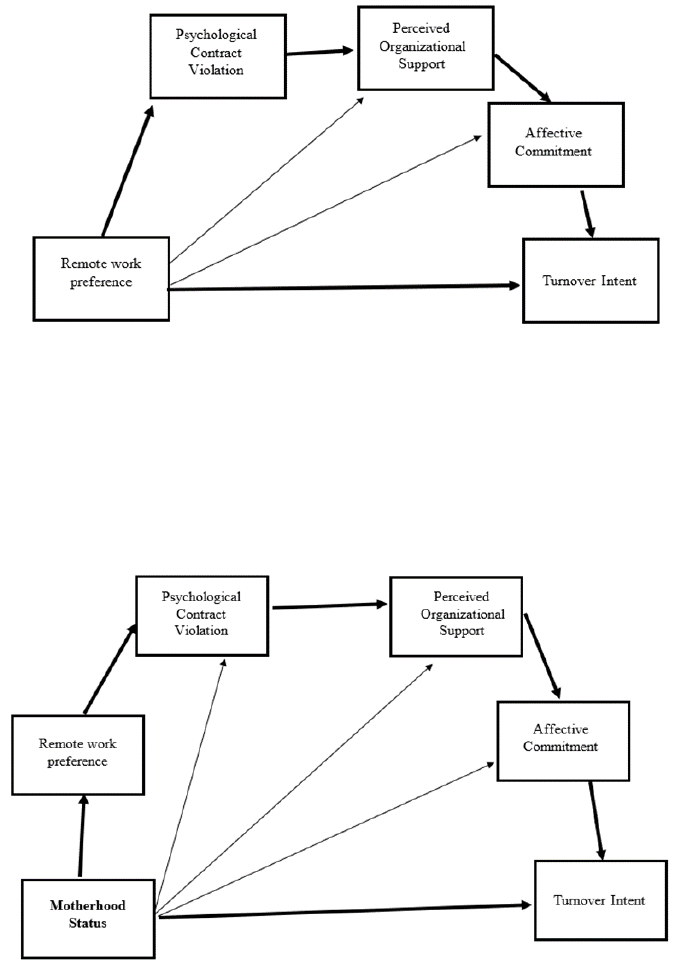
LOSS OF REMOTE WORK AS PSYCH. CONTRACT VIOLATION 91
APPENDIX C. FIGURES
Figure 1. The positive relationship between remote work preference and turnover intent will be
serially mediated by the interrelated constructs of psychological contract violation, POS, and
affective commitment.
Figure 2. Higher turnover intent for working mothers can be explained by the interrelated
variables of remote work preference, psychological contract violation, POS, and affective
commitment.

LOSS OF REMOTE WORK AS PSYCH. CONTRACT VIOLATION 92
Figure 3. Affective commitment partially mediates the relationship between preference for
greater days worked remotely and intentions to leave the organization.
Figure 4. Perceived organizational support and affective commitment partially and serially
mediate the relationship between attitudinal preference for onsite work and intentions to leave
the organization.
**
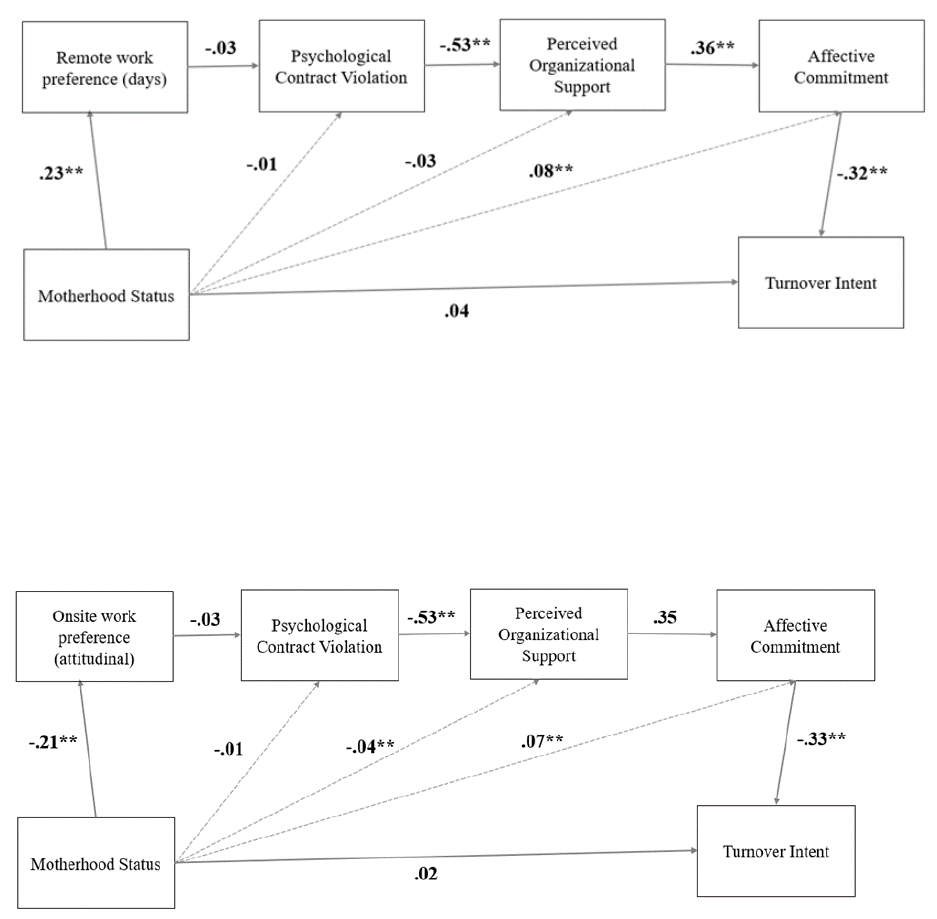
LOSS OF REMOTE WORK AS PSYCH. CONTRACT VIOLATION 93
Figure 5. Only temporal remote work preference and affective commitment serially mediate the
relationship between motherhood status and turnover intent.
Figure 6. Attitudinal preference for onsite work, perceived organizational support, and affective
commitment serially mediate the relationship between motherhood status and turnover intent.
**
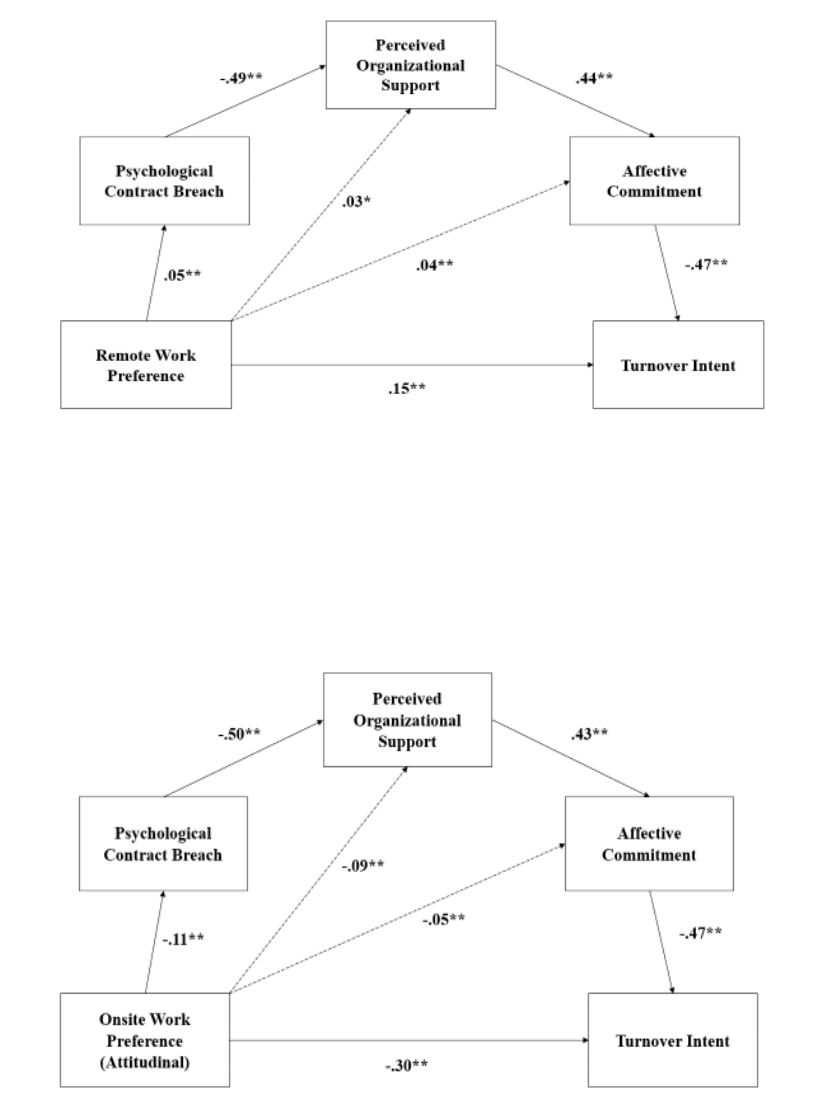
LOSS OF REMOTE WORK AS PSYCH. CONTRACT VIOLATION 94
Figure 7. Psychological contract breach, perceived organizational support, and affective
commitment serially mediate the relationship between remote work preference and turnover
intent.
Figure 8. PCB, POS, and AC serially mediate the relationship between attitudinal preference for
onsite work and turnover intent.
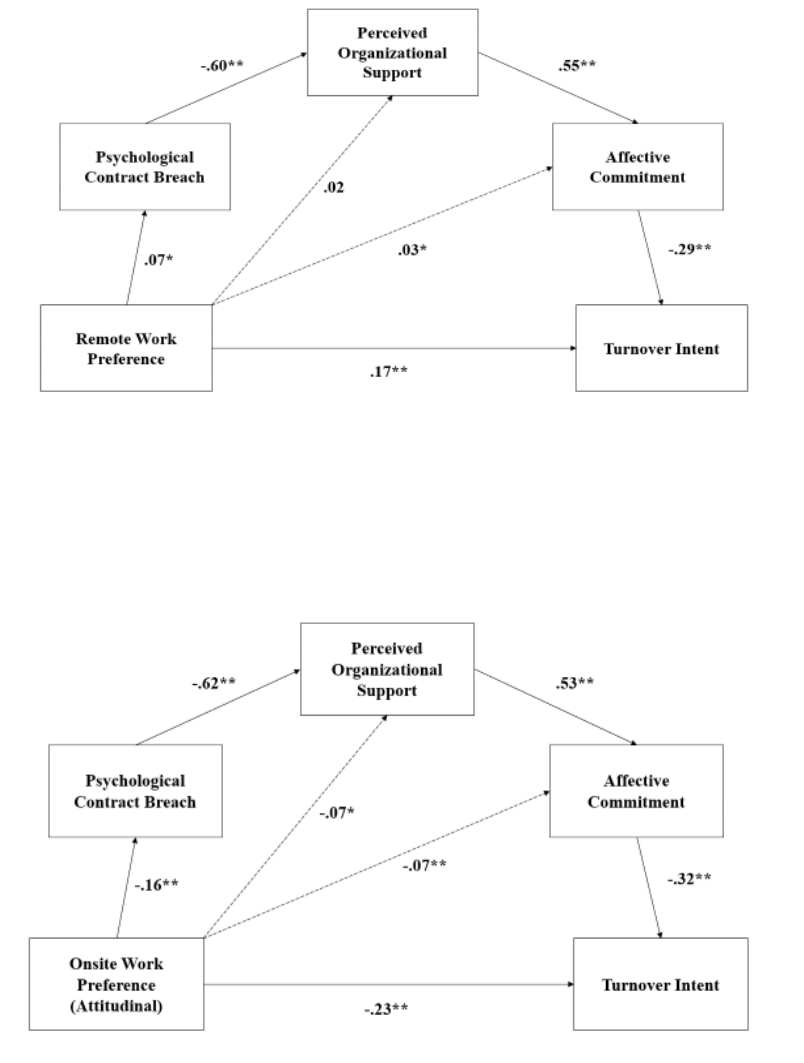
LOSS OF REMOTE WORK AS PSYCH. CONTRACT VIOLATION 95
Figure 9. When tested using only participants who work in-person at least 50%, a similar pattern
emerges: PCB, POS, and AC serially mediate the relationship between remote work preference
and turnover intent.
Figure 10. When tested using only participants who continue to work in-person at least 50% of
working hours, PCB, POS, and AC serially mediate the relationship between onsite work
preference and turnover intent.
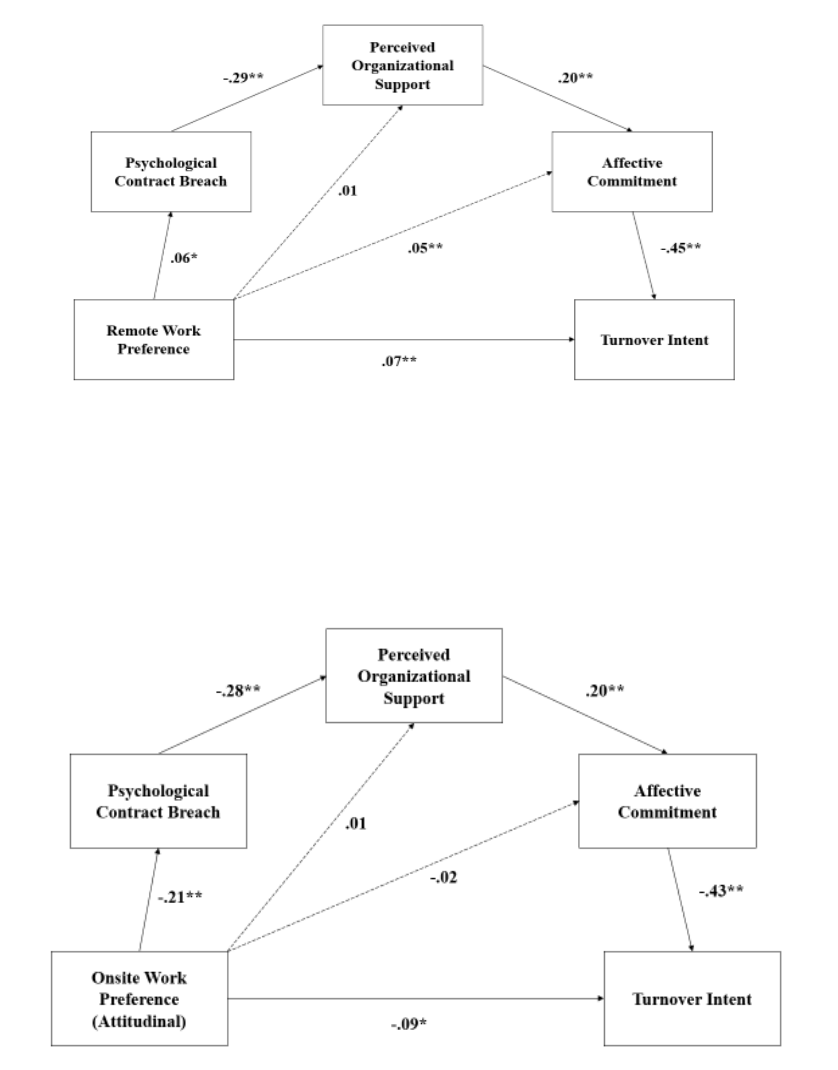
LOSS OF REMOTE WORK AS PSYCH. CONTRACT VIOLATION 96
Figure 11. When tested using only participants who are no longer working in person 50% or
more, the serial mediation model was still supported, albeit with smaller effect sizes.
Figure 12. When tested using only participants who are no longer working in person 50% or
more of their working hours, the serial mediation model was still supported with smaller effect
sizes.
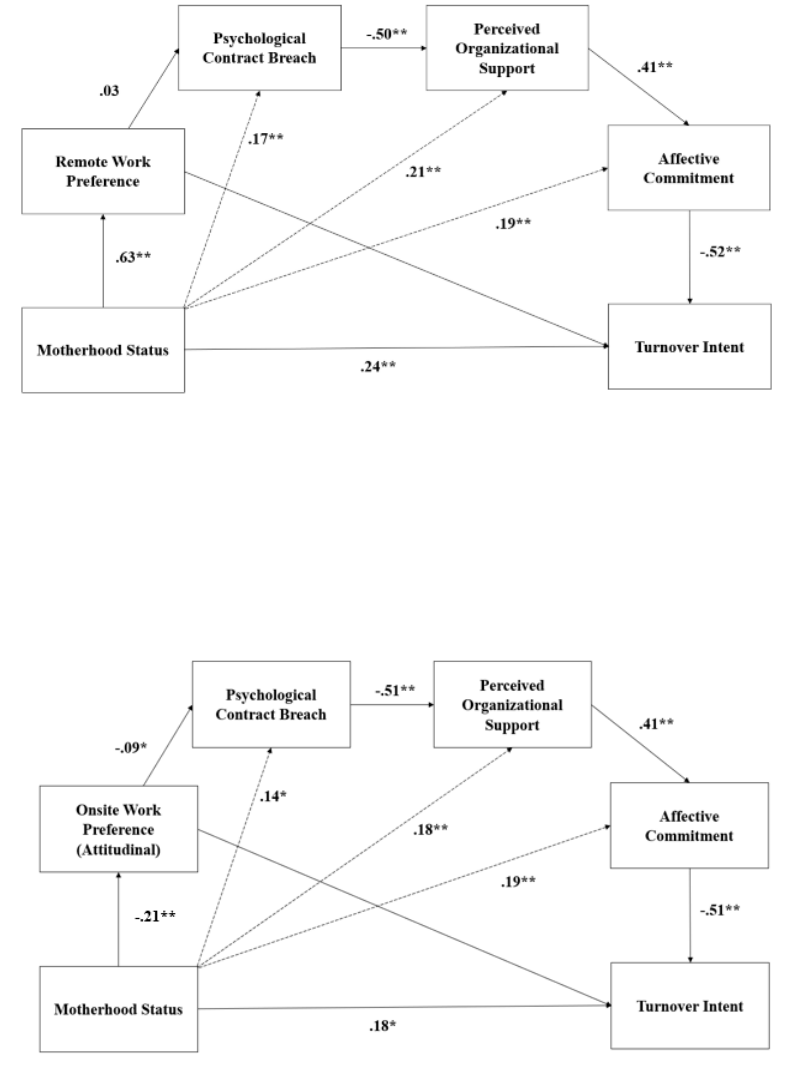
LOSS OF REMOTE WORK AS PSYCH. CONTRACT VIOLATION 97
Figure 13. When tested using the entire qualifying sample, remote work preference, PCB, POS,
and AC did not serially mediate the relationship between motherhood status and turnover intent.
Figure 14. When tested using the entire qualifying sample, onsite work preference, PCB, POS,
and AC serially mediate the relationship between motherhood status and turnover intent.
*
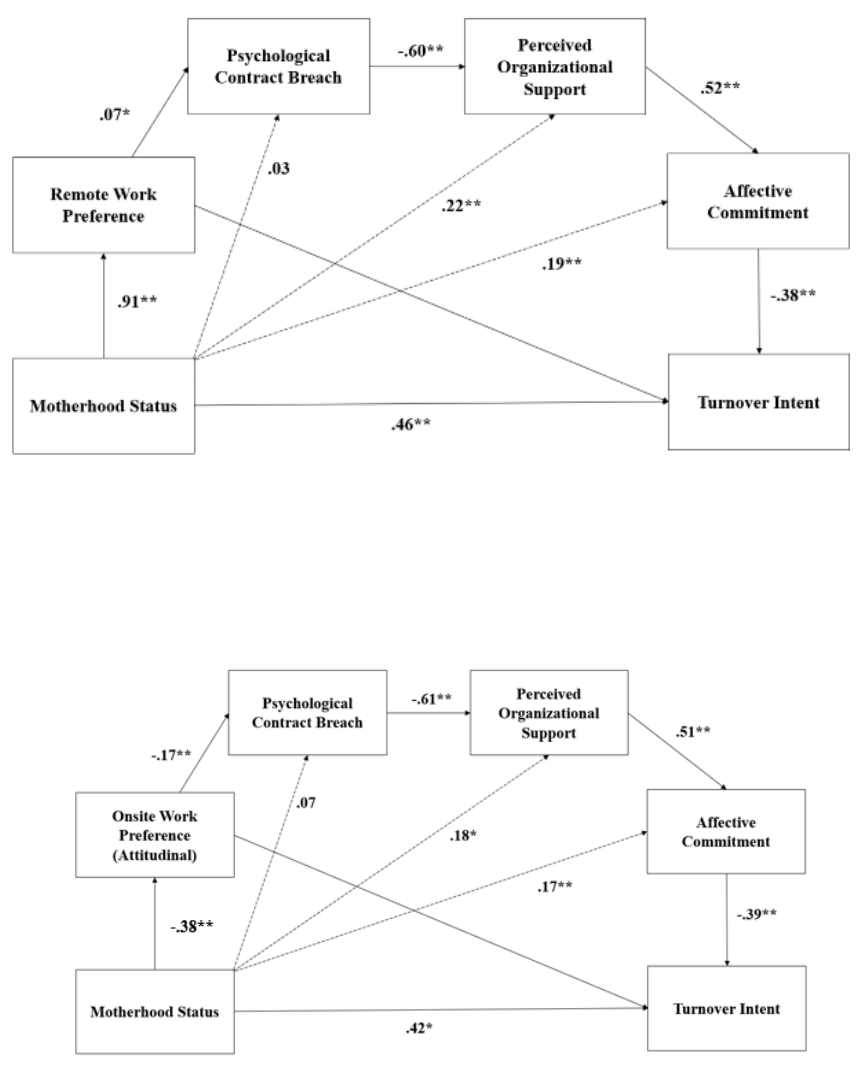
LOSS OF REMOTE WORK AS PSYCH. CONTRACT VIOLATION 98
Figure 15. When tested for participants continuing to work in-person more than 50%, remote
work preference, PCB, POS, and AC serially mediate the relationship between motherhood
status and turnover intent.
Figure 16. When tested using a sample of participants who are still working onsite at least 50%
of their work hours, onsite work preference, PCB, POS, and AC serially mediate the relationship
between motherhood status and turnover intent.
*
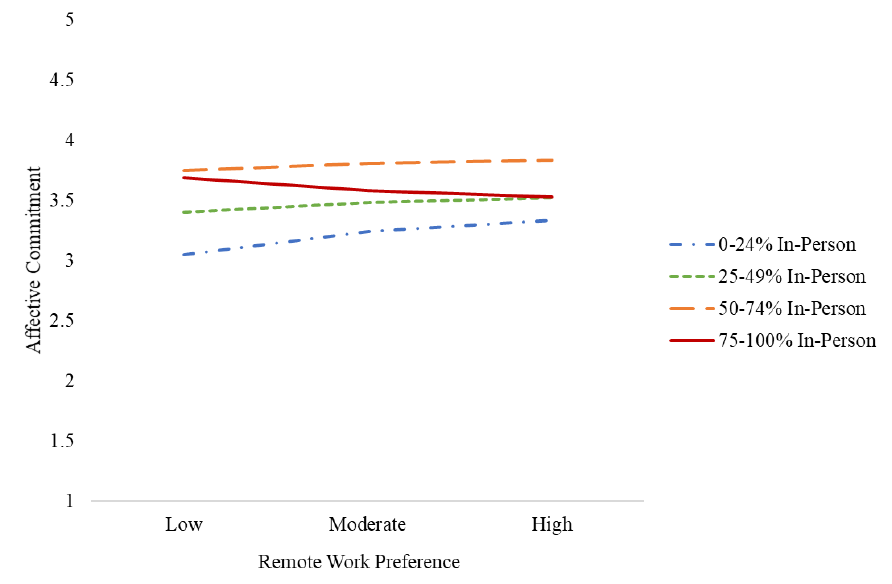
LOSS OF REMOTE WORK AS PSYCH. CONTRACT VIOLATION 99
Figure 17. In-person work percentage moderates the relationship between remote work
preference and affective commitment such that the relationship is negative for participants
working in person more than 75% of their work time. Moderate remote work preference reflects
the mean, while low and high refer to 1 standard deviation below and 1 standard deviation above
the mean, respectively.
